Inbox and Environment News: Issue 457
July 5 - 18, 2020: Issue 457
Pittwater Powerful Owl Nesting Site Razed: Chicks No Longer Present
Sad news as another action of bad land management in the Northern Beaches LGA causes one Powerful Owl family to abandon the nest hollow on Friday June 26th, along with the chicks that would have been inside the hollow. This pair are known to be regularly having chicks at this time of year (Winter is breeding season for Powerful Owls) and the site is in Pittwater.
There are 30 registered with Council Powerful Owl sites across the northern beaches. It has been suggested a process whereby landowners are notified they are buying or have bought a block in a sensitive area, with endangered species present, form part of Council’s processes. This site was cleared not only of weeds but native species and all understorey as well parts of the council and community owned reserve adjacent to it.
Although Council officers ordered a stop work, the contractors ceased then returned the very next day to complete their razing of the site.
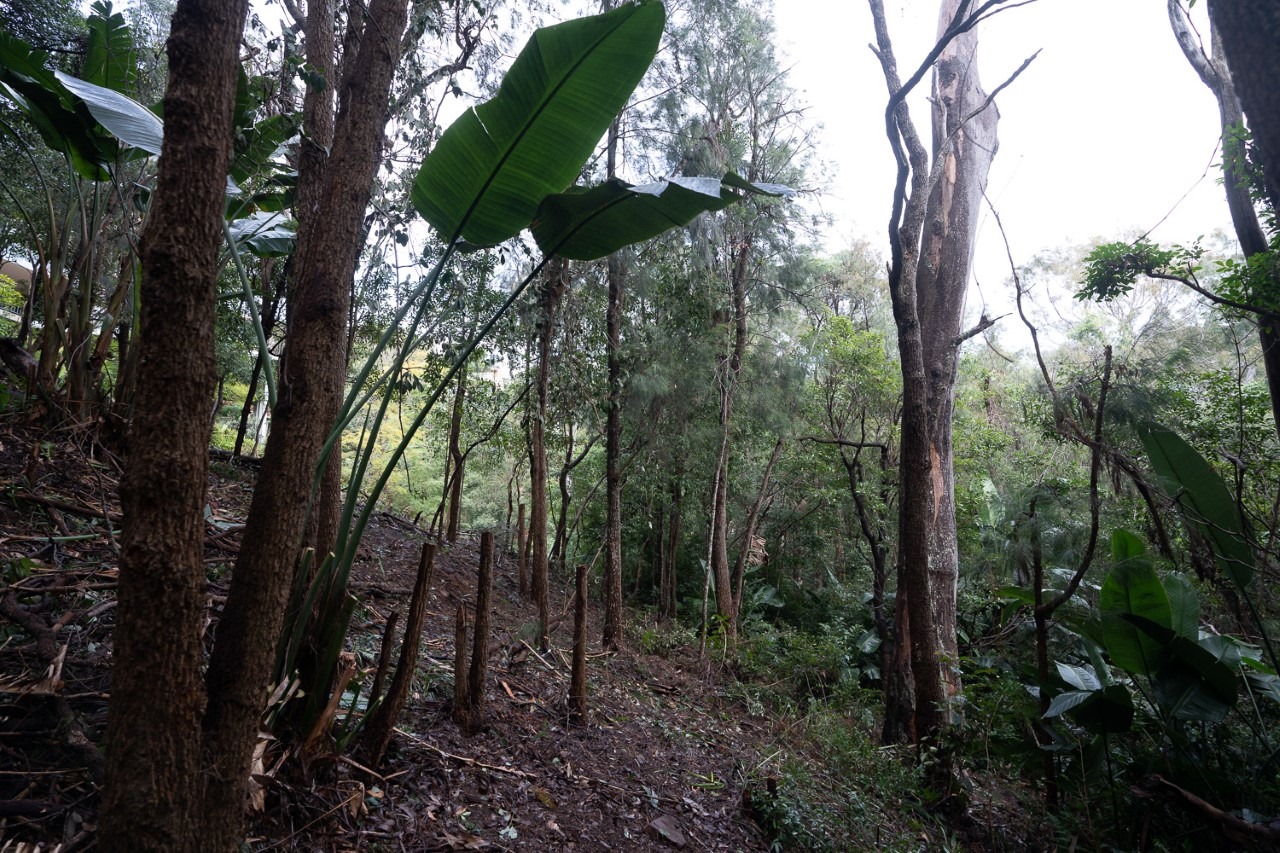
The Council Reserve cleared by contractors employed by private landowners - photo supplied
Pittwater Online News will run more on the Powerful Owl Project and what we can do to help look after these other local residents after the Winter School holidays.
If you are noticing the loss of your resident POs through fire, nest site vegetation removal, dog-walking, bike riding or visitation/photography, you are not alone. This season the Powerful Owl Project have already recorded three owl families moving away from nest trees in response to these activities. In one case the first nesting was early enough that the owls have made a second attempt at breeding, but for our Pittwater owl family - there will be no chicks that survive this year. You may have read about them here in December 2019:
Powerful owls: the reason to protect remnant bushland in our cities by Andrew Gregory. Australian Geographic, December 29, 2019.
Powerful Owl at Clareville - photographed by Paul Wheeler in June 2014
Australasian Grebe Photographed In Pittwater Wetlands
The Australasian Grebe (Tachybaptus novaehollandiae - Podicipedidae) is usually confined to freshwater wetlands, and can often be seen swimming singly or in twos on farm dams. This one, photographed last weekend, June 28, is a current Pittwater resident and one of a few birds usually seen more frequently inland, that has moved to the coast for water and food. A report from the NSW Department of Planning, Industry and Environment this week (runs below) shows that many of our inland areas are still suffering from drought.
These birds build floating nests —a platform made from green aquatic vegetation — into which bluish-white eggs are laid, sometimes by two females. When the young hatch they have striped down and proportionally oversized webbed feet, and are able to swim almost immediately. Not becoming independent for eight weeks after hatching, they follow their parents about, and they sometimes nestle onto the back of a swimming adult to rest.
The non-breeding plumage of both the male and female is dark grey-brown above and mostly silver-grey below, with a white oval patch of bare skin at the base of the bill. During the breeding season, both sexes have a glossy-black head and a rich chestnut facial stripe which extends from just behind the eye through to the base of the neck. At this time, the eye becomes darker and the patch of skin at the base of the bill becomes pale yellow and more noticeable.
The Australasian Grebe has a lobed or paddle flaps feet - this one, shown stretching, makes this clearly visible.
Almost all aquatic birds, ones that swim, have webbed feet - Grebes and Coots have evolved an alternative solution to webbed feet to augment the paddle power of their feet - the lobed foot.
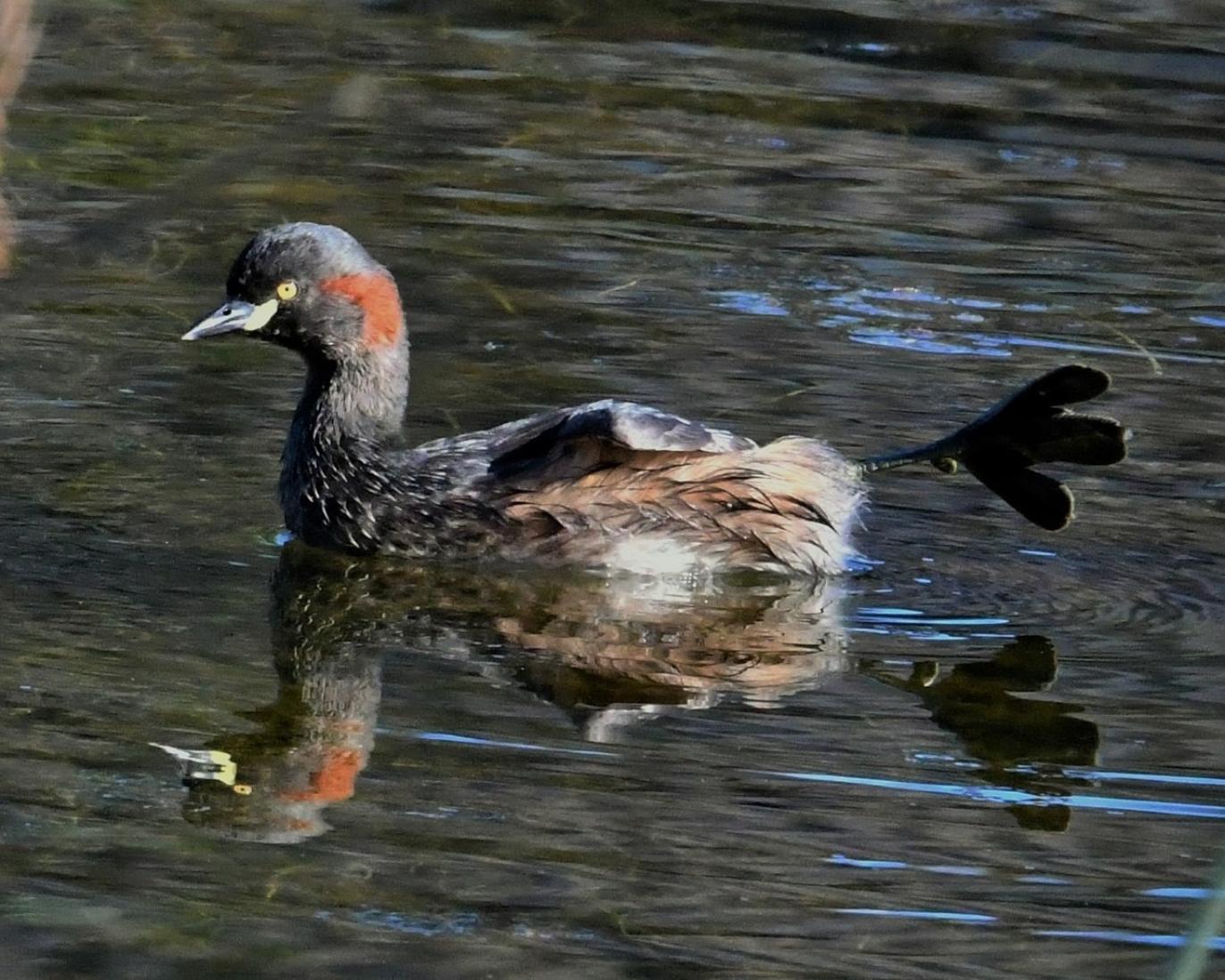
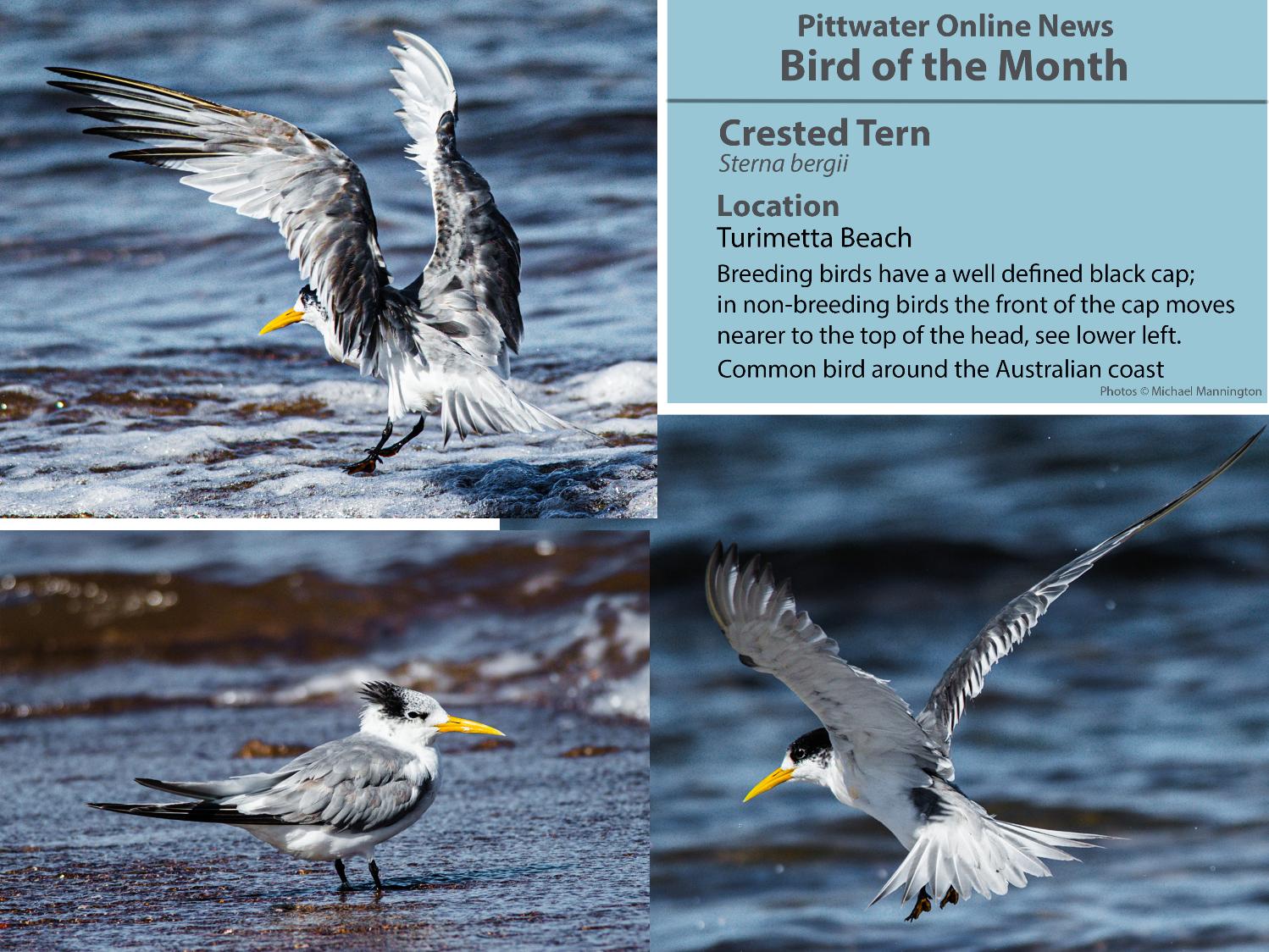
Bushcare Is Back!
Protocols are now in place so you can get involved in your local bushcare group again or sign up to help out to see your investment in your community grow - literally!
Find out how in: Bushcare is Back
Ku-Ring-Gai Chase National Park Precinct Closures Update
Many COVID-19 restrictions have now been lifted from visitor precincts and facilities In Ku-ring-gai Chase National Park. However, several tracks and trails will remain closed while upgrades and remediation works are completed. These closures include:
- Bobbin Head playground
- Warrimoo walking track - public access may be restricted on Wednesday 17 and Thursday 18 June.
- The Basin trail
- The Basin campground and picnic area
- Mackerel service trail
- Salvation Loop and Wallaroo trails
Berowra track, between Apple Tree Bay and the intersection of Mount Ku-ring-gai track, has now reopened. However if you plan to visit, walk with caution as some sections of the track remain uneven.
Closed areas: The Basin campground, Basin trail and Mackerel service trail closed
The following areas will be closed from Monday 1 June until Monday 3 August 2020 while upgrade works and maintenance are underway:
- The Basin trail
- The Basin campground and picnic area
- Mackerel service trail
No public access is permitted. There will be no access to The Basin Aboriginal Engraving Site, Mackerel Beach to The Basin trail, West Head Road or The Basin campground.
For further information call 02 9451 3479 or 02 9472 8949.
Closed areas: Salvation Loop and Wallaroo Trails closed for maintenance.
The Salvation Loop Trail and Wallaroo Trail at West Head will be closed from 2 June 2020 until early July 2020 for maintenance. Machinery will be on the trails so no public access is permitted for safety reasons.
For further information contact; (02) 9451 3479 or (02) 9472 8949
Please remember to practice appropriate social distancing requirements and good hygiene. From Saturday 13 June, the maximum group size for an outdoor gathering will be increasing from 10 to 20 people. Groups are still expected to maintain social distancing. If you arrive at a national park or other public space and it is too crowded to practice social distancing, it is your responsibility to leave the area. Do not wait to be instructed by NPWS staff or police.
The closure of toilets and other facilities will be decided on a case-by-case basis. Necessary site assessments will take place to consider the management of health and safety risk to visitors and staff, and available resourcing to maintain facilities. Access to sanitation products and running water cannot be guaranteed. We recommend bringing hand soap, hand wipes and toilet paper with you to maintain good hygiene as advised by the NSW Government.
If you're visiting the park, please bring a card to pay vehicle entry fees.
For more information about closures, call the NPWS Contact Centre on 1300 072 757, the NPWS North Western Sydney area office on 02 8448 0400 or the NPWS Sydney North area office on 02 9451 3479.
Penalties apply for non-compliance.
Stopping koala extinction is agonisingly simple. But here's why I'm not optimistic
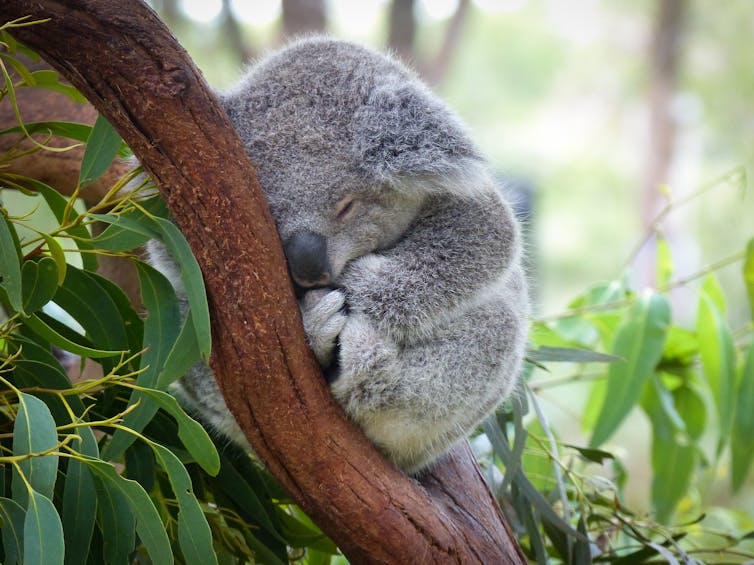
On Tuesday, a year-long New South Wales parliamentary inquiry revealed the state’s koalas are on track for extinction in the wild by 2050, without urgent government intervention.
Habitat destruction and fragmentation for agriculture, urban development, mining and forestry has been the number one koala killer since European occupation of Australia. This is compounded by the unabated impacts of climate change, which leads to more extreme droughts, heatwaves and bushfires.
Read more: Scientists find burnt, starving koalas weeks after the bushfires
Koala populations in NSW were already declining before the 2019-2020 bushfires. The report doesn’t mince words, saying “huge swathes of koala habitat burned and at least 5,000 koalas perished”.
The report, ambitiously, makes 42 recommendations, and all have merit. The fate of NSW koalas now relies on a huge commitment from the Berejiklian government to act on them. But past failures by a federal government inquiry into koalas suggest there’s little cause for optimism.
First, let’s look at the report’s key recommendations and how they might ensure the species’ survival in NSW.
Leadership Needed At The Local Level
Real, on-ground koala conservation actions take place at the local level. “Local” is where councils give development approvals, sometimes to clear koala habitat. And it’s where communities and volunteers work on the front line to save and protect the species.
Recommendation 10 in the report addresses this, suggesting the NSW government provide additional funding and support to community groups so they can plant trees and regenerate bushland along koala and wildlife corridors.
Read more: A report claims koalas are 'functionally extinct' – but what does that mean?
Another two recommendations build on this: encouraging increased funding from the NSW government to local councils to support local conservation initiatives, and suggesting increased resources to support councils to conduct mapping.
Mapping, such as where koalas have been recorded and their habitat, is a critical component for local councils to develop comprehensive koala management plans.
Stop Offsetting Koala Habitat
One recommendation suggests a review of the “biodiversity offsets scheme”, where generally developers must compensate for habitat loss by improving or establishing it elsewhere. It is embedded in the NSW Biodiversity Conservation Act 2016, and other state and territory governments commonly use offsets in various conservation policies.
Read more: The Blinky Bill effect: when gum trees are cut down, where do the koalas go?
But the report recommends prohibiting offsets for high quality koala habitat. Prohibiting offsets is important because when a vital part of koala habitat is cleared, it can no longer support the local koalas. Replacing this habitat somewhere else won’t save that particular population.
Build The Great Koala National Park
It’s of paramount importance to increase the connected, healthy koala habitat in NSW, particularly after the bushfires.
One tool to achieve this is laid out in recommendation 41: to investigate establishing the Great Koala National Park. Spearheaded by the National Parks Association of NSW, this national park would see 175,000 hectares of publicly owned state forests added to existing protected areas.
It total, it would form a 315,000 hectare reserve in the Coffs Harbour hinterland dedicated to protecting koalas – an Australian first.
Read more: What does a koala's nose know? A bit about food, and a lot about making friends
It would be a great day if such a park was established and replicated throughout the NSW and Queensland hinterlands. Research shows that in those regions, the future climate will remain suitable for koalas, and urbanisation, agriculture and mining are not currently present in these parks.
But it’s worth noting Australia’s national parks are under increasing pressure from “adventure tourism”. Human recreation activities can fragment habitat and disturb wildlife, for example by constructing tracks and access roads through natural areas.
Humans must not be allowed to compromise dedicated koala conservation areas. Intrusive recreational activity is detrimental to the species, and can also reduce the chance quiet park visitors might spy a koala sitting high in a tree, sleepily munching on gum leaves.
This rule should apply both to existing national parks, and a new Great Koala National Park.
Failures Of Past Inquiries
The tragic fate predicted for koalas in NSW depends on the state government’s willingness to act on the recommendations. Developing wordy, well-intentioned documents is simply not enough.
We need look no further than Australia’s key environmental legislation, the Environment Protection and Biodiversity Conservation (EPBC) Act, to realise this.
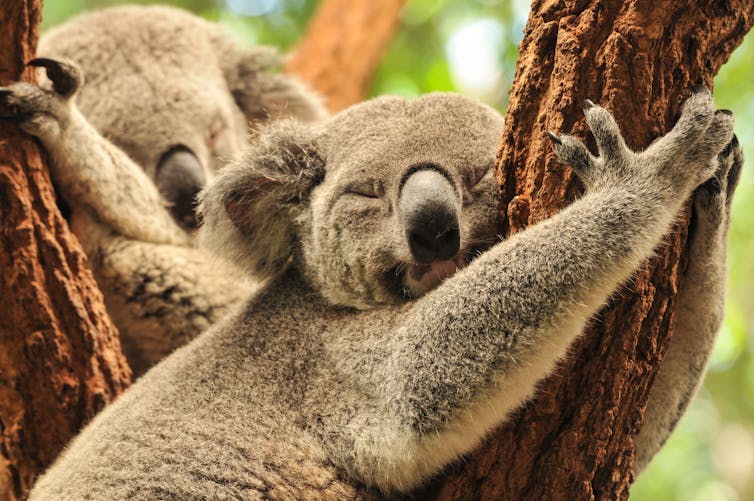
After a 2012 Senate inquiry into the health and status of koalas, the species was officially listed as “vulnerable” under the EPBC Act. But since then, tree clearing and declines in koala numbers have continued at a furious pace across Queensland and NSW.
One of the shortcomings of the federal listing for the koala is in its Referral Guidelines, which recommends “proponents consider these guidelines when proposing actions within the modelled distribution of the koala”. In other words, informing the government about clearing koala habitat is only voluntary. And that’s not good enough.
Read more: Environment laws have failed to tackle the extinction emergency. Here's the proof
The failure of the 2012 inquiry and the EPBC Act to protect koalas should serve as a wake-up call to the NSW government. It must start implementing the recommendations of the current inquiry without delay to ensure Australia’s internationally celebrated species doesn’t die out.
Koala conservation must take priority over land clearing, regardless of the demand for that land. That principle might seem simple, but so far it’s proved agonisingly difficult.![]()
Christine Hosking, Conservation Planner/Researcher, The University of Queensland
This article is republished from The Conversation under a Creative Commons license. Read the original article.
Let there be no doubt: blame for our failing environment laws lies squarely at the feet of government
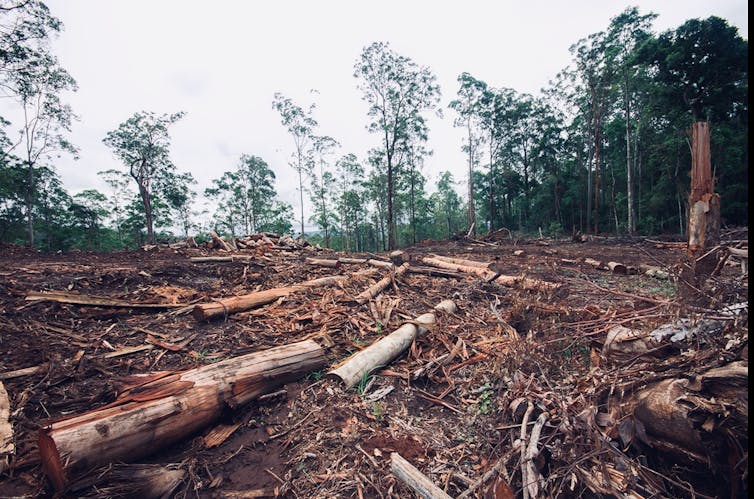
A long-awaited draft review of federal environment laws is due this week. There’s a lot riding on it – particularly in light of recent events that suggest the laws are in crisis.
Late last week, the federal Auditor-General Grant Hehir tabled a damning report on federal authorities’ handling of the Environment Protection and Biodiversity Conservation (EPBC) Act. Incredibly, he found Australia’s premier environmental law is administered neither efficiently or effectively.
It followed news last month that mining company Rio Tinto detonated the 46,000 year old Juukan rock shelters in the Pilbara. The decision was authorised by a 50 year old Western Australian law –and the federal government failed to invoke emergency powers to stop it.
Also last month we learned state-owned Victorian logging company VicForests unlawfully logged 26 forest coupes, home to the critically endangered Leadbeater’s possum. The acts were contrary both to its own code of practice, and the agreement exempting VicForests from federal laws.
As relentless as Hehir’s criticisms of the department are, let there be no doubt that blame lies squarely at the feet of government. As a society, we must decide what values we want to protect, count the financial cost, then make sure governments deliver on that protection.

Shocking Report Card
I’ve been involved with this Act since before it began 20 years ago. As an ACT environment official reading a draft in 1998 I was fascinated by its complexity and sweeping potential. As a federal official responsible for administering, then reforming, the Act from 2007-2012, I encountered some of the issues identified by the audit, in milder form.
But I was still shocked by Hehir’s report. It’s so comprehensively scathing that the department barely took a trick.
Overall, the audit found that despite the EPBC Act being subject to multiple reviews, audits and parliamentary inquiries since it began, the Department of Agriculture, Water and the Environment’s administration of the laws is neither efficient nor effective.
Read more: Mr Morrison, you can cut 'green tape' without harming nature – but it'll take money and gumption
While the government is focused on efficiency, the lack of effectiveness worries me most – especially findings concerning so-called “environmental offsets”. These are measures designed to compensate for unavoidable losses, such as creating a nature reserve near a site to be cleared.
In the early years of the law, offsets were rare. By 2015 they featured in almost 90% of decisions, dropping to about 75% last year. In effect, we now rely on offsets to protect the environment.
The Auditor-General found that the absence of guidance and quality control for offsets has led to “realised risks”.
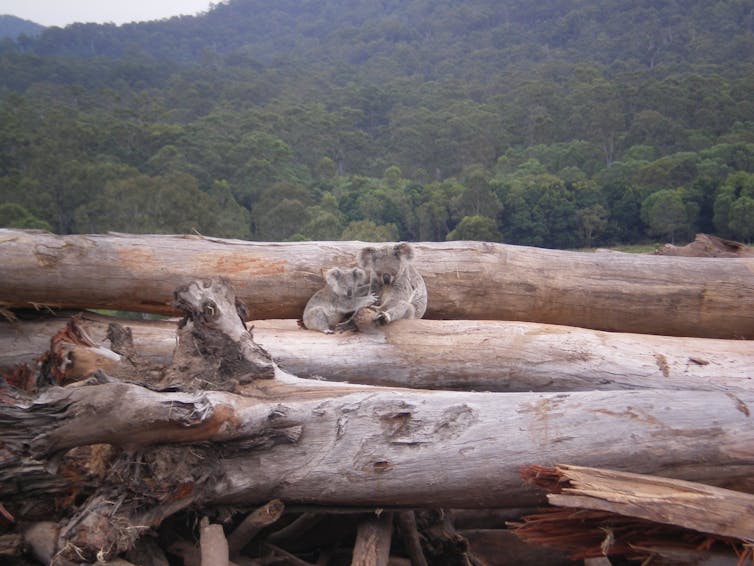
For example, offsets must be mapped and disclosed publicly, to ensure their integrity. But not only did the department fail to create a public register, in 2019 it stopped loading offset data into its systems altogether. This makes it likely offsets will be forgotten and so either destroyed later, or put up a second time and thus double-counted.
Hehir cites one example where the department accepted offsets for damage to koala habitat in 2015 that did not meet its offset standards. After negotiations with the developer and involvement from the Minister’s office, the department accepted the offsets. Worse, the developer secured a futher non-complying offset for a second development in 2018, arguing for consistency with the previous decision.
Apart from politicisation and failure to protect the environment, this case reveals a significant legal issue. Under administrative law, a decision is invalid if it has regard to an “irrelevant consideration”. An offset in one development in 2015 is surely irrelevant to an offset in another development in 2018.
Read more: Environment laws have failed to tackle the extinction emergency. Here's the proof
Offsets aside, the Auditor-General higlighted key risks such as high volumes of unapproved land clearing for agriculture, and non-compliance in residential and mining developments. The department had proposed actions to address the issues, but made no progress on them.
And the report found arrangements to monitor whether approval conditions had been met before work started on a project were inadequate, which “leaves the department poorly positioned to prevent adverse environmental outcomes”.
At the end of the day, the federal department doesn’t have the tools to distinguish whether an environmental effect is the result of its own regulations, or other factors such as state programs or extreme weather. Essentially, it doesn’t know if the Act is delivering any environmental benefits at all.
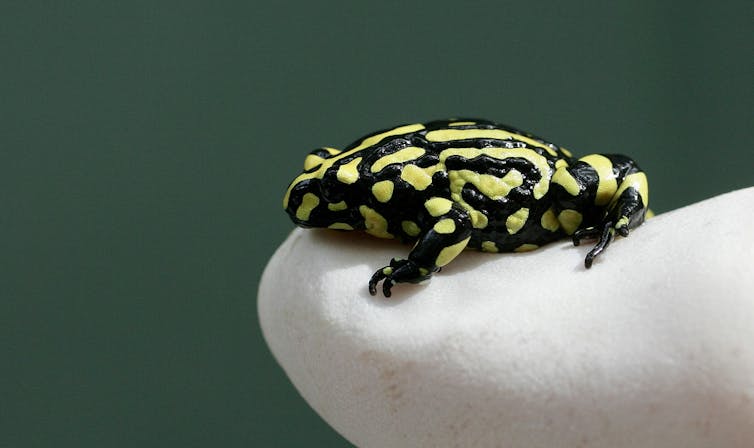
How Did This Happen?
The EPBC Act itself remains a powerful instrument. Certainly changes are needed, but the more significant problems lie in the processes that should support it: plans and policies, information systems and resourcing.
As I wrote last month, between 2013 and 2019 the federal environment department’s budget was cut by an estimated 39.7%.
And while effective administration of the Act requires good information, this can be hard to come by. For example the much-needed National Plan for Environmental Information, established in 2010, was never properly resourced and later abolished.
Read more: Our nature laws are being overhauled. Here are 7 things we must fix
Officials are constrained here. The audit scope does not extend to the government decisions shaping departmental performance. And the department loyally refrains from complaining that government decisions leave it few options.
So while the audit office and the department might believe extensive government cuts are the underlying problem, neither can say so. I’m not excusing the department’s poor performance, but it must manage with what it’s given. When faced with critical audit findings, it can only pledge to “reprioritise” resources.
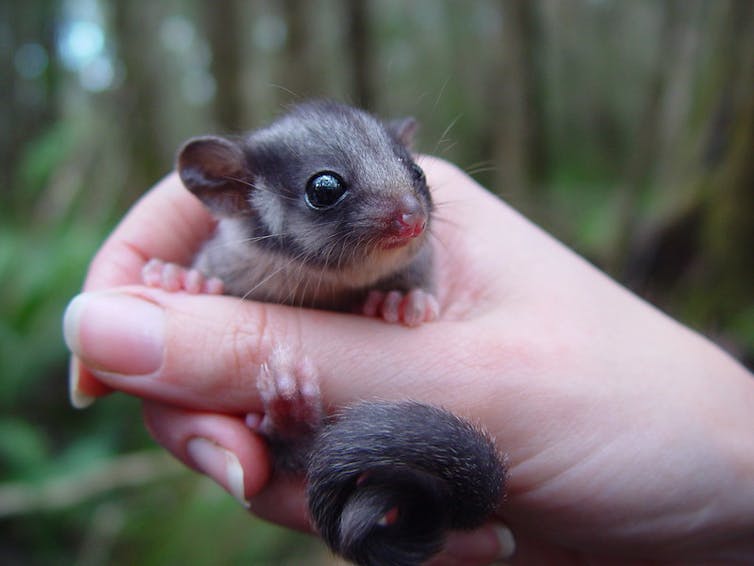
A National Conversation
There is a small saving grace here. Hehir says the department asked that his report be timed to inform Professor Graeme Samuel’s 10-year review of the EPBC Act. Hehir timed it perfectly – Samuel’s draft report is due by tomorrow. Let’s hope it recommends comprehensive action, and that the final report in October follows through.
Beyond Samuel’s review, we need a national conversation on how to fix laws protecting our environment and heritage. The destruction of the Juukan rock shelters, unlawful logging of Victorian forests and the Auditor-General’s report are incontrovertible evidence the laws are failing.
I don’t believe we can lock nature up. But we must look after the things that enable nature to provide not just life, but quality of life. This includes a stable climate, our Indigenous and non-Indigenous heritage and the resilience that comes from nature’s richness and diversity.![]()
Peter Burnett, Honorary Associate Professor, ANU College of Law, Australian National University
This article is republished from The Conversation under a Creative Commons license. Read the original article.
NSW Water Allocations Reflect Some Easing After Record Drought Conditions
July 1, 2020
Today’s water allocations announced by the NSW Department of Planning, Industry and Environment for licensed water users reflect some improvement in resource availability, particularly for towns and high priority entitlements.
“While supplies for towns and stock and domestic and other high priority uses are secured for the coming year, new allocations for general security water users on regulated rivers will again be low or zero across much of the State,” Vanessa O’Keefe, Executive Director Policy, Planning & Sciences, said.
“While the coastal catchments are much better placed for the coming year, water availability across the entire Murray-Darling Basin remains seriously depleted.
“Total storage levels for WaterNSW operated dams, excluding the Snowy, are about 6,118 gigalitres, which is 34.5 per cent of total storage capacity.
“While this is about 3.5 per cent higher than this time last year – unfortunately the situation for many water users is still grim. Despite some rainfall in recent months, and recovery of soil moisture for croppers, major storages have missed out on inflows meaning there is little resource improvement to allocate.
Ms O’Keefe said that while many parts of the NSW coast had received decent rain at the start of the year, inland rainfall in most cases had failed to boost storage levels in most places, resulting in small initial allocations for many licenced water users.
“Today’s commencing water allocations reflect a slow recovery from record dry conditions affecting much of inland NSW.
“In the far west of NSW the situation for water users on the Lower Darling has taken a turn for the better, with Menindee Lakes currently at 29 per cent of capacity.
“This means that water can be run along the entire length of the Lower Darling for the first time in almost two years.
“Based on current storage levels in the lakes – there should be enough water to run the river for at least the next 12 to 18 months.
“While this is wonderful news for the people and communities along the Lower Darling, I remain hopeful that winter rains may bolster dam levels across the state and provide much needed water for NSW towns, irrigators, industry and the environment,” she said.
The Bureau of Meteorology has forecast wetter than average conditions for much of NSW during August to October.
“The department will continue to monitor conditions closely so that any possible increases to water allocations can be announced if further water becomes available,” Ms O’Keefe said.
Additional information on available water determinations can be found on the department’s Water website.
Temporary Water Restriction For Upper Lachlan Groundwater
July 2, 2020
The NSW Department of Planning, Industry and Environment today announced a temporary water restriction for the Upper Lachlan groundwater management zone 1 in the Upper Lachlan Alluvial Groundwater Source.
The temporary water restriction is required to address a severe decline in groundwater levels in the management zone in order to prevent irreversible damage to the aquifer and protect groundwater dependent ecosystems.
Licensed water users who draw from this management zone are restricted to 0.3ML per unit share of their access licence. Trading of water is restricted to ensure that no more than 0.3ML per unit share is extracted within the management zone.
The restrictions on both water take and trade are designed to decrease demand sufficiently to allow the aquifer to recharge above the critical threshold.
These restrictions will remain in force up to and including 1 July 2021, unless that date is amended or the order is repealed before that date.
For more information visit the department's temporary water restrictions webpage.
Temporary Water Restriction For Mortons Creek Applied
July 2, 2020
The NSW Department of Planning, Industry and Environment today announced a temporary water restriction which applies to the Mortons Creek Water Source.
A temporary water restriction was in place for the Hastings Unregulated and Upriver Alluvial Water Source and the Hastings River Coastal Floodplain Alluvial Groundwater Source to control unregulated river and aquifer access licence extractions in the Hastings water source.
The Hastings restriction was necessary to maintain water supply for Basic Landholder Rights, Stock and Domestic and Local Water utility licence holders, including supply for Port Macquarie, during the switch to updated cease-to-pump licence conditions under the new water sharing plan. This restriction expired 30 June 2020.
The revised licence conditions for water users covered by the Hastings unregulated and alluvial water sources water sharing plan have been completed for all water access licence holders. However, water sharing plan amendments are needed, impacting on those who draw water from the Mortons Creek water source.
The department is currently working through the necessary administrative procedures to up-date the rules in the water sharing plan that will apply to water users on Mortons Creek.
The restriction on Mortons Creek Water Source will remain in place until 11 December 2020. However, it can be repealed once the water sharing plan has been amended, new licence conditions are imposed and licence holders have been notified.
For more information visit the department's temporary water restrictions webpage.
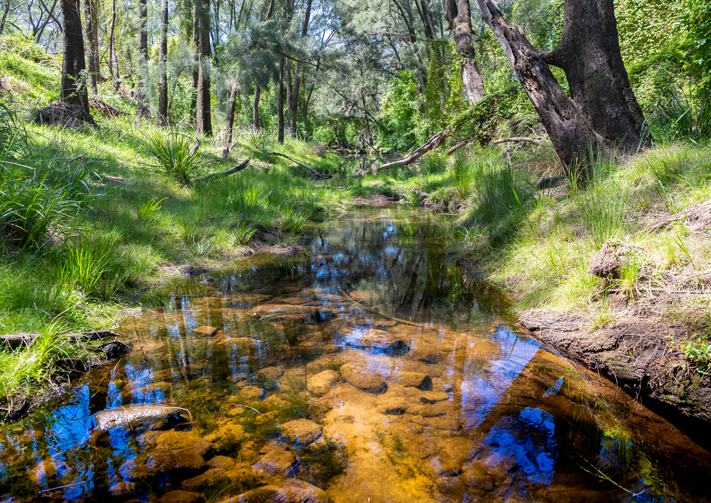
Water Regulator Commences Prosecution Of Mine At Maules Creek
July 2, 2020
The state’s independent water regulator has commenced prosecution in the Land and Environment Court of a mine operator at Maules Creek near Boggabri in the state’s north west.
The state’s independent water regulator has commenced prosecution in the Land and Environment Court of a mine operator at Maules Creek near Boggabri in the state’s north west.
The Natural Resources Access Regulator (NRAR) is charging the Whitehaven Coal-owned Maules Creek Coal Pty Ltd with two alleged breaches of section 60A(2) of the Water Management Act 2000 for taking water without an access licence over a three-year period between 2016 and 2019, or in the alternative section 60C(2).
The alleged breaches relate to the failure to divert clean water from major streams on the site, instead capturing the water on the mine site.
The maximum penalty for a breach of section 60A(2) for a company is $2,002,000.
NRAR Chief Regulatory Officer Grant Barnes said the alleged failure to obtain licences for the water taken impacts on other water users and the environment – especially during severe drought.
“As this matter is now before the court, NRAR cannot comment further on the case.”
To see the work NRAR does, go to its public register on the NRAR website industry.nsw.gov.au/nrar. Go to ‘Reports and data’, then ‘NRAR Public Register’.
To make a confidential report on suspected water misuse, go to industry.nsw.gov.au/nrar or contact the NRAR Hotline on 1800 633 362 during business hours.
Companies Held To Account By Water Regulator
July 3, 2020
The state’s water regulator is holding two companies to account in separate prosecutions for alleged breaches of the Water Management Act 2000.
A macadamia nut nursery company, its manager and the property owner from the Ballina area received a total of $16,000 in fines for breaches of the NSW water laws in Ballina Local Court yesterday.
In a case brought by the Natural Resources Access Regulator (NRAR), the company pleaded guilty to two alleged breaches of section 60A(2) of the Water Management Act 2000 for taking water without an access licence, and two alleged breaches of section 91B(2) for using a pump, tank and pipes to take and use water without a water supply work approval. The company received a fine of $10,000 and was ordered to pay legal costs of $7,000.
The breaches took place between June 2016 and July 2018.
The property owner pleaded guilty to one alleged breach of section 60A(2) of the Water Management Act 2000 for taking water without an access licence which covered several alleged instances. The property owner received a fine of $1,000 and was ordered to pay court costs of $2,000.
The manager of the business pleaded guilty to one alleged breach of section 60A(2) of the Water Management Act 2000 for taking water without an access licence and one alleged breach of section 91B(2) for using a pump, tank and pipes to take and use water without a water supply work approval. The manager received a fine of $5,000 and was ordered to pay legal costs of $3,000.
A company from Lithgow operating a property in the Narrabri Shire Council area is the subject of another prosecution by NRAR, this time in the Land and Environment Court. The company has been charged with an alleged breach of section 60C of the Water Management Act 2000 - taking water for which they did not have an allocation.
The company is also the subject of separate proceedings begun at an earlier date for alleged breaches of section 91I of the Act, regarding bores on its property.
NRAR’s Chief Regulatory Officer Grant Barnes said the public had higher expectations of companies than of individuals.
“Companies should have adequate systems in place to comply with the law; the community expects nothing less,” he said.
“It is critical for the integrity of the state’s water management system that users of water hold licences and approvals, as failure to do so can harm other water users and the environment.”
NRAR’s investigators and compliance officers travel all over the state’s 58 water sharing plan areas, inspecting properties and assessing compliance with water users’ licences and the Water Management Act 2000. NRAR officers follow all NSW Health COVID-19 guidelines when making site visits.
To see the work NRAR does, go to its public register on the NRAR website industry.nsw.gov.au/nrar. Go to ‘Reports and data’, then ‘NRAR Public Register’.
To make a confidential report on suspected water misuse, go to industry.nsw.gov.au/nrar or contact the NRAR Hotline on 1800 633 362 during business hours.
National Parks And Wildlife Service On A Mission To Recruit 125 New Staff
The NSW National Parks and Wildlife Service (NPWS) is hiring 125 new staff across NSW. These staff will play a vital role in managing a world class network of 870 national parks including through effective fire management and feral animal control.
Atticus Fleming, Deputy Secretary of NPWS said the focus of this recruitment drive is to enable an increase in hazard reduction activity in national parks and to ensure more NPWS firefighters are in place before the 2020–21 bushfire season.
"Field officers are at the frontline protecting our national parks and threatened wildlife – fighting fires is a key priority, as well as delivering feral animal control and maintaining walking tracks and other infrastructure and supporting threatened species conservation projects," said Mr Fleming.
"We are on the hunt for problem solvers who have a passion for the Australian bush, who can use initiative and think on their feet and who will bring a good practical approach to their work," Mr Fleming said.
"The work is varied and will be well supported with training opportunities. Importantly, this is a chance to make a difference as one of the team protecting 7.2 million hectares of national parks, from the islands of Sydney Harbour, to the desert country in the north west, the forests along the Great Dividing Range and the alpine country in the Snowy Mountains" he said.
"This is the opportunity of a lifetime, and NPWS is an equal opportunity employer, so I encourage everyone to apply," he said.
Applications are invited from people of all genders and many of the roles are targeted for employment of Aboriginal people.
"As one of the State's 4 frontline firefighting agencies, NPWS works closely with other agencies to manage fire both inside and outside national parks," he said.
This recruitment is supported by $22.9 million in funding committed by the NSW Government as an interim budget boost ahead of the next bushfire season. This funding will also be used for an additional helicopter to ensure rapid response teams are well placed to protect people, property and the environment. Further information is available online.
Recruitment is open until Monday 6 July 2020. Further information about the roles is available at I work for NSW, where applications may be submitted.
First Confirmed Underwater Aboriginal Archaeological Sites Found Off Australian Coast
July 1, 2020
Ancient submerged Aboriginal archaeological sites await underwater rediscovery off the coast of Australia, according to a study published July 1, 2020 in the open-access journal PLOS ONE by Jonathan Benjamin of Flinders University, Adelaide, Australia and colleagues.
Aboriginal artefacts discovered off the Pilbara coast in Western Australia represent Australia’s oldest known underwater archaeology. The discoveries were made through a series of archaeological and geophysical surveys in the Dampier Archipelago, as part of the Deep History of Sea Country Project, funded through the Australian Research Council’s Discovery Project Scheme.
An international team of archaeologists from Flinders University, The University of Western Australia, James Cook University, ARA – Airborne Research Australia and the University of York (United Kingdom) partnered with the Murujuga Aboriginal Corporation to locate and investigate ancient artefacts at two underwater sites which have yielded hundreds of stone tools made by Aboriginal peoples, including grinding stones.
In a study published today in PLOS ONE, the ancient underwater sites, at Cape Bruguieres and Flying Foam Passage, provide new evidence of Aboriginal ways of life from when the seabed was dry land, due to lower sea levels, thousands of years ago.
At the end of the Ice Age, sea level was much lower than today, and the Australian coastline was 160 kilometers farther offshore. When the ice receded and sea level rose to its current level, approximately two million square kilometers of Australian land became submerged where Aboriginal peoples had previously lived. Thus, it is likely that many ancient Aboriginal sites are currently underwater.
The submerged cultural landscapes represent what is known today as Sea Country to many Indigenous Australians, who have a deep cultural, spiritual and historical connection to these underwater environments.
“Today we announce the discovery of two underwater archaeological sites that were once on dry land. This is an exciting step for Australian archaeology as we integrate maritime and Indigenous archaeology and draw connections between land and sea,” says Associate Professor Jonathan Benjamin who is the Maritime Archaeology Program Coordinator at Flinders University’s College of Humanities, Arts and Social Sciences.
“Australia is a massive continent but few people realise that more than 30% of its land mass was drowned by sea-level rise after the last ice age. This means that a huge amount of the archaeological evidence documenting the lives of Aboriginal people is now underwater.
“Now we finally have the first proof that at least some of this archaeological evidence survived the process of sea level rise. The ancient coastal archaeology is not lost for good; we just haven’t found it yet. These new discoveries are a first step toward exploring the last real frontier of Australian archaeology.”
The dive team mapped 269 artefacts at Cape Bruguieres in shallow water at depths down to 2.4 metres below modern sea level. Radiocarbon dating and analysis of sea-level changes show the site is at least 7000 years old.
The second site at Flying Foam Passage includes an underwater freshwater spring 14 metres below sea level. This site is estimated to be at least 8500 years old. Both sites may be much older as the dates represent minimum ages only; they may be even more ancient.
The team of archaeologists and geoscientists employed predictive modelling and various underwater and remote sensing techniques, including scientific diving methods, to confirm the location of sites and presence of artefacts.
“At one point there would have been dry land stretching out 160 km from the current shoreline. That land would have been owned and lived on by generations of Aboriginal people. Our discovery demonstrates that underwater archaeological material has survived sea-level rise, and although these sites are located in relatively shallow water, there will likely be more in deeper water offshore” says Chelsea Wiseman from Flinders University who has been working on the DHSC project as part of PhD research.
“These territories that are now underwater harboured favourable environments for Indigenous settlements including freshwater, ecological diversity and opportunities to exploit marine resources which would have supported relatively high population densities” says Dr Michael O’Leary, a marine geomorphologist at The University of Western Australia.”
These findings demonstrate the utility of these exploratory techniques for locating submerged archaeological sites. The authors hope that these techniques can be expanded upon in the future for systematic recovery and investigation of ancient Aboriginal cultural artefacts. They further urge that future exploration will rely not only on careful and safe scientific procedures, but also on legislation to protect and manage Aboriginal cultural heritage along the Australian coastline.
The discovery of these sites emphasises the need for stronger federal legislation to protect and manage underwater heritage across 2 million square kilometres of landscapes that were once above sea level in Australia, and hold major insights into human history.
“Managing, investigating and understanding the archaeology of the Australian continental shelf in partnership with Aboriginal and Torres Strait Islander traditional owners and custodians is one of the last frontiers in Australian archaeology” said Associate Professor Benjamin.
“Our results represent the first step in a journey of discovery to explore the potential of archaeology on the continental shelves which can fill a major gap in the human history of the continent” he said.
In Murujuga, this adds substantial additional evidence to support the deep time history of human activities accompanying rock art production in this important National Heritage Listed Place.
Murujuga Aboriginal Corporation CEO Peter Jeffries says the discoveries will help the community add to the story of Aboriginal people in the Pilbara.
“Further exploration could unearth similar cultural relics and help us better understand the life of the people who were so connected to these areas of land which are now underwater.
“With this comes a new requirement for the careful management of Aboriginal sea country as it’s not automatically protected by current Heritage legislation, however plans are progressing to lead this change and protect our sea country land and heritage.”
Deep History of Sea Country Project with Murujuga Aboriginal Corporation
Jonathan Benjamin, Michael O’Leary, Jo McDonald, Chelsea Wiseman, John McCarthy, Emma Beckett, Patrick Morrison, Francis Stankiewicz, Jerem Leach, Jorg Hacker, Paul Baggaley, Katarina Jerbić, Madeline Fowler, John Fairweather, Peter Jeffries, Sean Ulm, Geoff Bailey. Aboriginal artefacts on the continental shelf reveal ancient drowned cultural landscapes in northwest Australia. PLOS ONE, 2020; 15 (7): e0233912 DOI: 10.1371/journal.pone.0233912
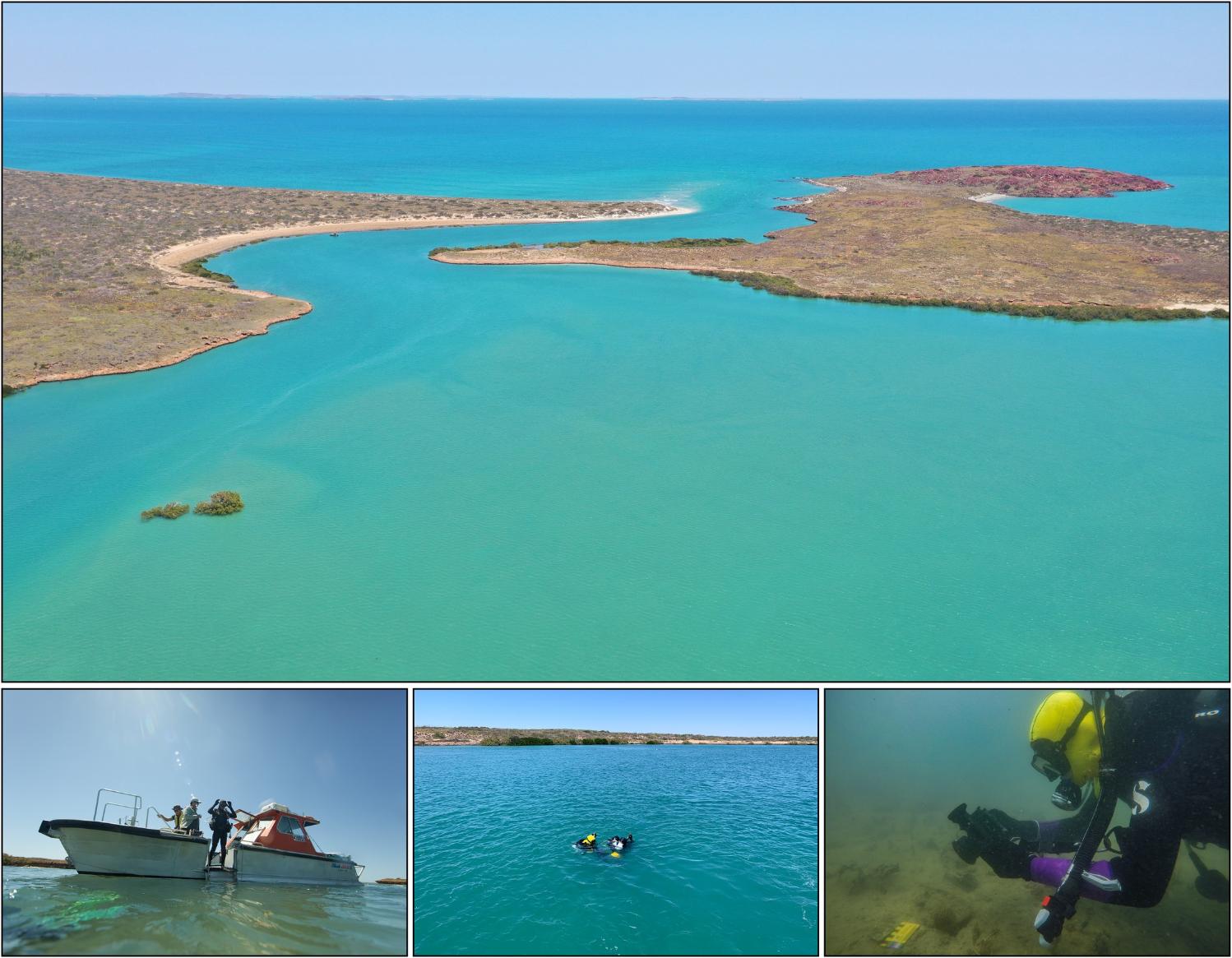
Westward facing aerial view of Cape Bruguieres Channel at high tide (Photo: J. Leach); (below) divers record artefacts in the channel (Photos: S. Wright, J. Benjamin, and M. Fowler).
45,000 renewables jobs are Australia’s for the taking – but how many will go to coal workers?
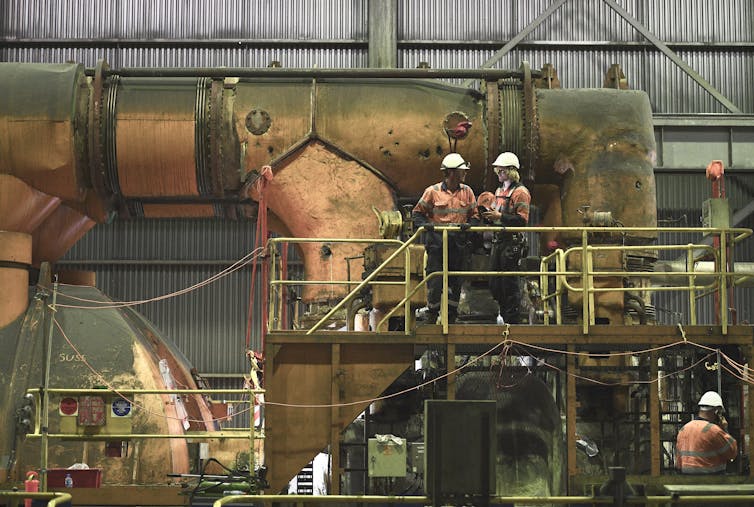
As the global renewables transition accelerates, the future for coal regions has become a big worry. This raises an important question: can renewables create the right jobs in the right places to employ former coal workers?
According to our new research, the answer in many cases is “yes”. Renewable energy jobs provide a good match for existing coal jobs across a range of blue and white-collar occupations, including construction and project managers, engineers, electricians, site administrators and mechanical technicians.
But about one-third of coal workers, such as drillers and machine operators, cannot simply switch over to renewables jobs. So as our economy pivots to renewables, planning and investment is needed to help coal regions survive.
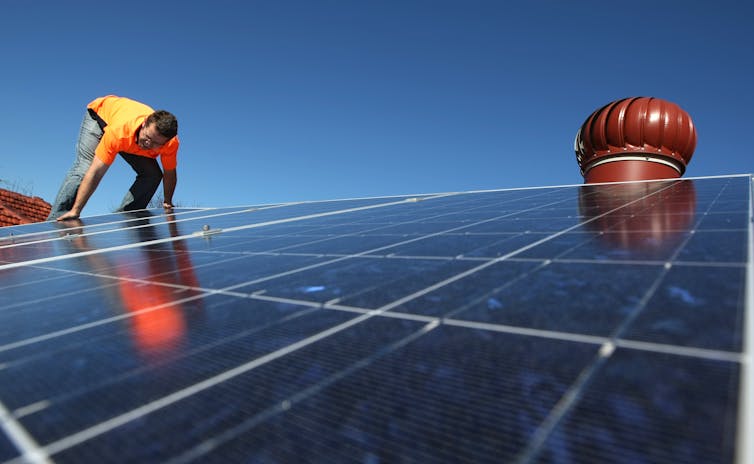
Renewables Jobs: A Snapshot
Our research, commissioned by the Clean Energy Council, is the first large-scale survey of renewable energy employment in Australia.
We surveyed more than 450 Australian renewable energy businesses, covering large scale wind, solar and hydro, rooftop solar and batteries. We wanted to find out how many people were employed, and in what jobs.
We then projected employment until 2035 using three scenarios for the future of the electricity market, developed by the Australian Energy Market Operator (AEMO).
Our results suggest renewable energy can be a major source of jobs in the next 15 years. But the trajectories are very different depending on government COVID-19 stimulus measures and wider energy policy.
Policy Crossroads
We found the renewable energy sector currently employs about 26,000 people. Temporary construction and installation jobs now comprise 75% of the renewable energy labour market, but as the sector grows, this will change (more on that later).
Australia’s renewable energy target was reached last year, and has not been replaced. According to the Reserve Bank of Australia this caused renewables investment to fall by 50% last year compared to 2018. Under a “central” scenario where these policies continued, 11,000 renewable jobs would be lost by 2022.
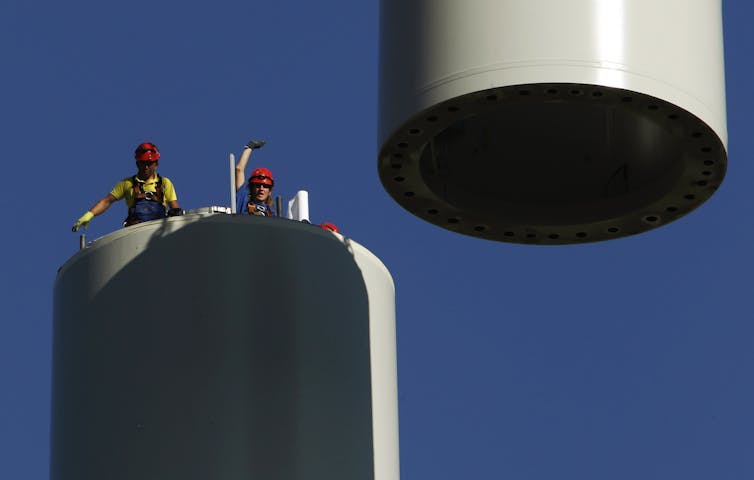
We then examined a “step change” scenario where Australian policy settings were in line with meeting the Paris climate agreement. This would create a jobs boom: renewable energy employment would grow to 45,000 by 2025 and average around 35,000 jobs each year to 2035. Up to two-thirds are in regional areas.
Under all scenarios, job growth is strongest in rooftop solar and wind. Most are in the construction and installation phase, comprising both ongoing and project-based jobs in trades, as well as technicians and labourers. But by 2035, as many as half of renewable energy jobs could be ongoing jobs in operation and maintenance.
Read more: People need to see the benefits from local renewable energy projects, and that means jobs
Renewable energy jobs will be higher than our projections. We excluded employment areas such as building electricity transmission networks, bioenergy, professional services, renewable hydrogen, growth in minerals needed for renewable energy, and jobs in heavy industry such as “green” steel.
Renewables Vs Coal Jobs
All up, coal mining in Australia employs about 40,000 people. As mentioned above, renewable energy jobs could grow to 45,000 by 2025 – and more once other sectors are included.
Australia’s renewable energy industry already employs considerably more people than the 10,500 working in the domestic coal sector – mostly thermal coal mining and power generation.
About 75% of coal mined in Australia is exported. About 24,000 people work in thermal coal mining for both domestic use and export – slightly fewer than the current renewable energy workforce.
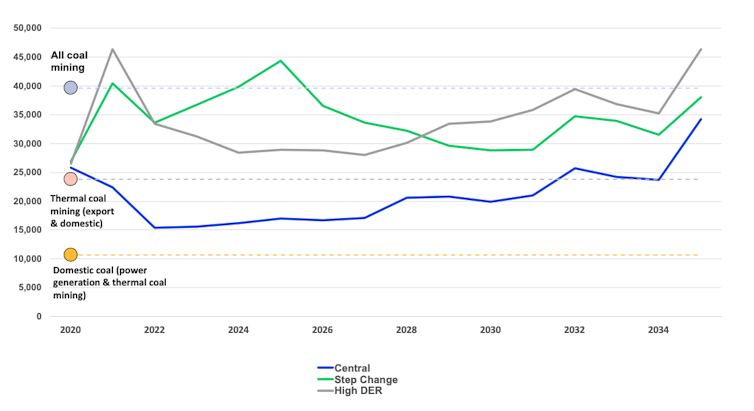
New Renewables Jobs In Coal Regions
Around two-thirds of renewable energy jobs could be created in regional areas. These would be distributed more widely than coal sector jobs.
The leading coal mining states, NSW and Queensland, have the biggest share of renewable energy jobs under all scenarios.
AEMO has identified “renewable energy zones” where most large-scale renewable energy is expected to be located. In both NSW and Queensland, some of these zones overlap with the coal workforce. In NSW, the Central West zone could also create employment in the Hunter region. In general, though, many renewable energy jobs will be located in other regions and the capital cities.
Read more: Really Australia, it's not that hard: 10 reasons why renewable energy is the future
In terms of occupations, there is overlap between coal and renewable energy. These include construction and project managers, engineers, electricians, mechanical trades, office managers and contract administrators and drivers.
The timing and location of these renewables jobs will influence whether they can be a source of alternative jobs for coal workers. Re-training of coal workers would also be required.
But there is no direct job overlap for the semi-skilled machine operators such as drillers, which account for more than one-third of the coal workforce.
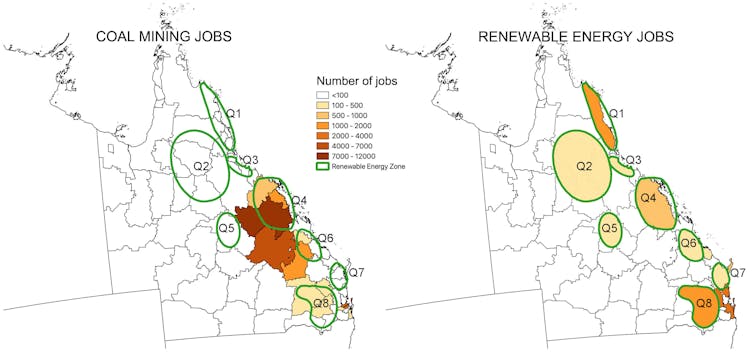
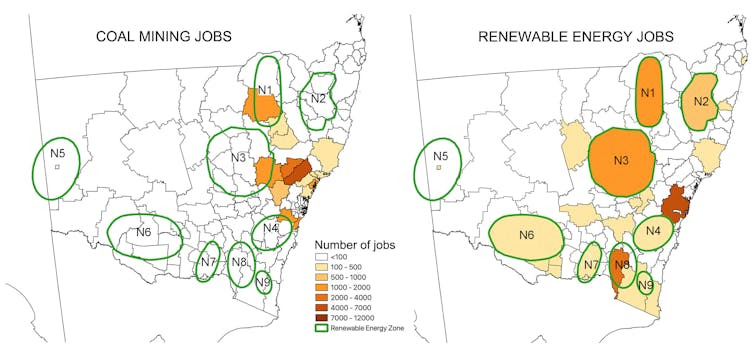
Planning For The Decline
Renewable energy can meaningfully help in the transition for coal regions. But it won’t replace all lost coal jobs, and planning and investment is needed to avoid social and economic harm.
Coal regions need industry development plans and investment to diversify their economies to other industries, including renewables. Almost half our coal workers are aged under 40, so Australia will not be able to follow Germany and Spain’s lead by relying on early retirement schemes.
At some point, demand for our coal exports will collapse – be it due to the falling cost of renewables, or policies to address climate change. If we don’t start preparing now, the consequences for coal communities will be dire.![]()
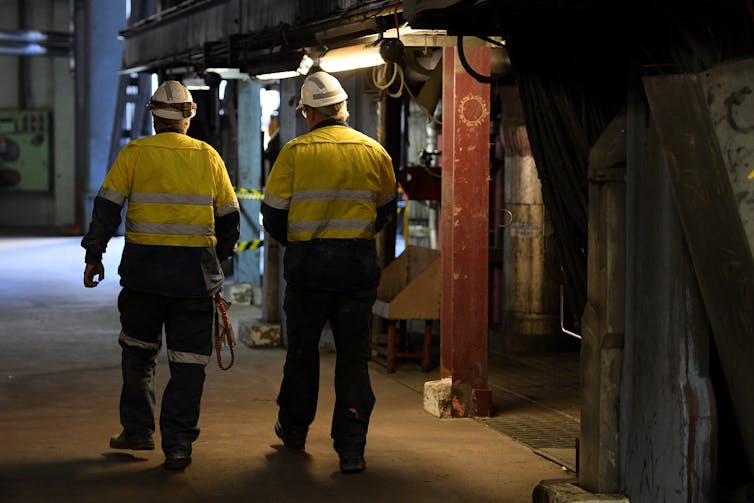
Chris Briggs, Research Principal, Institute for Sustainable Futures, University of Technology Sydney; Elsa Dominish, Senior Research Consultant, Institute for Sustainable Futures, University of Technology Sydney, and Jay Rutovitz, Research Director, Institute for Sustainable Futures, University of Technology Sydney
This article is republished from The Conversation under a Creative Commons license. Read the original article.
The world endured 2 extra heatwave days per decade since 1950 – but the worst is yet to come

The term “heatwave” is no stranger to Australians. Defined as when conditions are excessively hot for at least three days in a row, these extreme temperature events have always punctuated our climate.
With many of us in the thick of winter dreaming of warmer days, it’s important to remember how damaging heatwaves can be.
In 2009, the heatwave that preceded Black Saturday killed 374 people. The economic impact on Australia’s workforce from heatwaves is US$6.2 billion a year (almost AU$9 billion). And just last summer, extreme temperature records tumbled, contributing to Australia’s unprecedented bushfire season.
Our new study – the first worldwide assessment of heatwaves at the regional scale – found heatwaves have become longer and more frequent since 1950. And worryingly, we found this trend has accelerated.
We also examined a new metric: “cumulative heat”. This measures how much extra heat a heatwave can contribute, and the new perspective is eye-opening.
What Is ‘Extra Heat’?
In southeast Australia’s worst heatwave season in 2009, we endured an extra heat of 80℃. Let’s explore what that means.
For a day to qualify as being part of a heatwave, a recorded temperature should exceed an officially declared “heatwave threshold”.
And cumulative heat is generally when the temperature above that threshold across all heatwave days are added up.
Let’s say, for example, a particular location had a heatwave threshold of around 30℃. The “extra heat” on a day where temperatures reach 35℃ would be 5℃. If the heatwave lasted for three days, and all days reached 35℃, then the cumulative heat for that event would be 15℃.
Another Decade, Another Heatwave Day
We found almost every global region has experienced a significant increase in heatwave frequency since 1950. For example, southern Australia has experienced, on average, one extra heatwave day per decade since 1950.
Read more: Anatomy of a heatwave: how Antarctica recorded a 20.75°C day last month
However, other regions have experienced much more rapid increases. The Mediterranean has seen approximately 2.5 more heatwave days per decade, while the Amazon rainforest has seen an extra 5.5 more heatwave days per decade since 1950.
The global average sits at approximately two extra heatwave days per decade.
The Last 20 Years Saw The Worst Heatwave Seasons
Since the 1950s, almost all regions experienced significant increases in the extra heat generated by heatwaves.
Over northern and southern Australia, the excess heat from heatwaves has increased by 2-3℃ per decade. This is similar to other regions, such as western North America, the Amazon and the global average.
Alaska, Brazil and West Asia, however, have cumulative heat trends of a massive 4-5℃ per decade. And, for the vast majority of the world, the worst seasons occurred in the last 20 years.
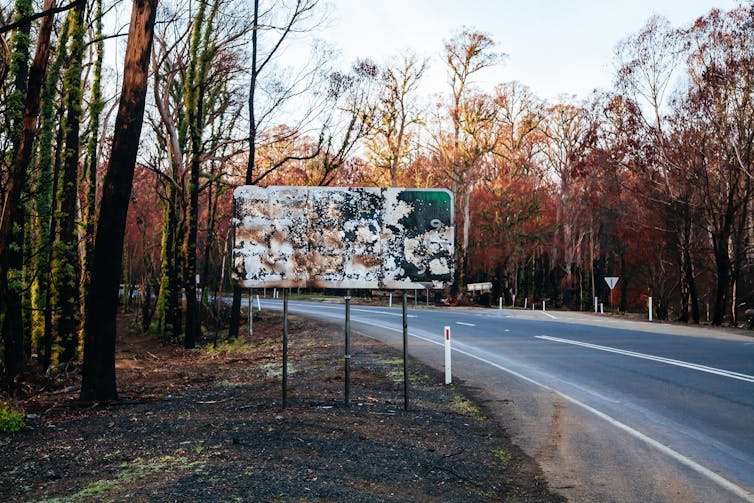
We also examined whether heatwaves were changing at a constant rate, or were speeding up or slowing down. With the exception of average intensity, we found heatwave trends have not only increased, but have accelerated since the 1950s.
Don’t Be Fooled By The Maths
Interestingly, average heatwave intensity showed little – if any – changes since 1950. But before we all breathe a sigh of relief, this is not because climate change has stopped, or because heatwaves aren’t getting any warmer. It’s the result of a mathematical quirk.
Read more: Climate change: 40°C summer temperatures could be common in UK by 2100
Since we’re seeing more heatwaves – which we found are also generally getting longer – there are more days to underpin the average intensity. While all heatwave days must exceed a relative extreme threshold, some days will exceed this threshold to a lesser extent than others. This brings the overall average down.
When we look at changes in cumulative heat, however, there’s just no denying it. Extra heat – not the average – experienced in almost all regions, is what can have adverse impacts on our health, infrastructure and ecosystems.
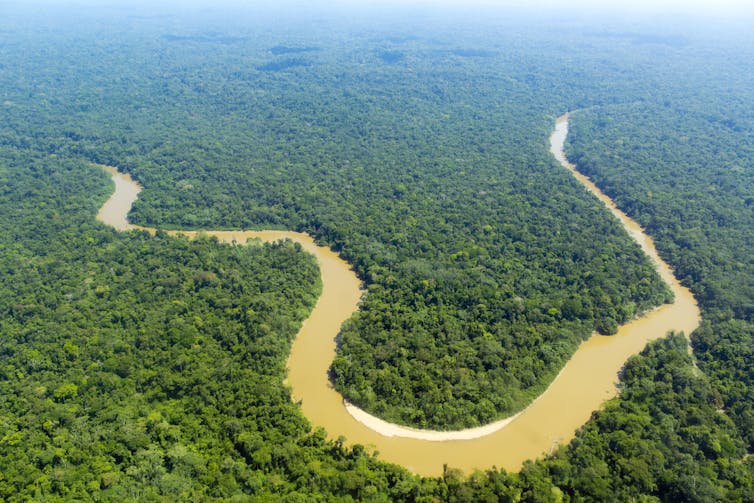
Like Nothing We’ve Experienced Before
While the devastating impacts of heatwaves are clear, it has been difficult to consistently measure changes in heatwaves across the globe. Previous studies have assessed regional heatwave trends, but data constraints and the spectrum of different heatwave metrics available have made it hard to compare regional changes in heatwaves.
Our study has closed this gap, and clearly shows heatwaves are on the rise. We are seeing more of them and they are generating more heat at an increasing pace.
Read more: We've learned a lot about heatwaves, but we're still just warming up
While Australia may be no stranger to heatwaves in the past, those we see in the future under these accelerating trends will certainly be foreign.
For example, a 2014 study found that depending on where you are in Australia, anywhere between 15 and 50 extra heatwave days will occur by 2100 compared to the second half of the 20th century.
We can still abate those trends if we work collectively, effectively and urgently to reduce our greenhouse gas emissions.![]()
Sarah Perkins-Kirkpatrick, ARC Future Fellow, UNSW
This article is republished from The Conversation under a Creative Commons license. Read the original article.
Giant sea scorpions were the underwater titans of prehistoric Australia
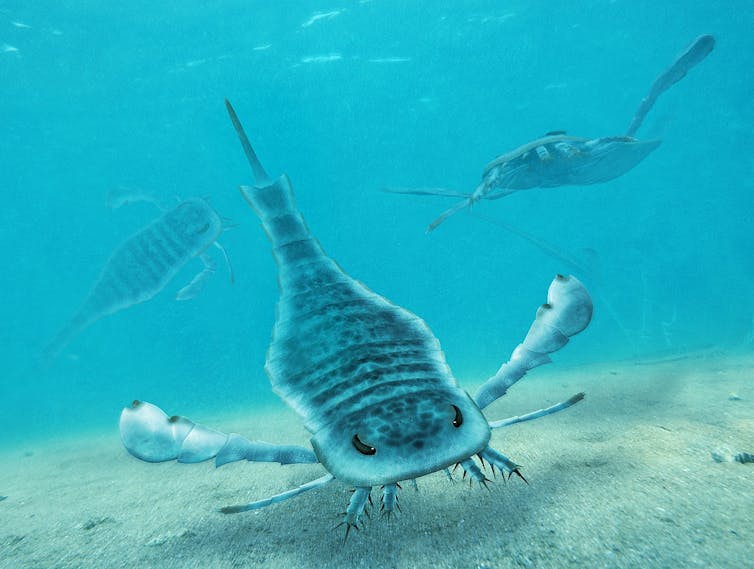
Let’s turn back the hands of time. Before extinction knocked dinosaurs off their pillar, before the “Great Dying” extinction wiped out 95% of all organisms – we had the Paleozoic Era.
During this age in Earth’s history, between 541 million and 252 million years ago, arthropods (animals with exoskeletons such as insects, crustaceans, scorpions, and horseshoe crabs) were exploring the extremes of size, from tiny to huge.
In fact, some Paleozoic arthropods represent the largest animals on Earth at the time. If you were to take a swim in the Paleozoic oceans, you may have been fortunate (or unfortunate) enough to find one of the most fearsome of these extinct arthropods: the sea scorpions, Eurypterida.
Our new research, published in Gondwana Research, is the most comprehensive collection of information on these fascinating creatures that once roamed Australian waters.
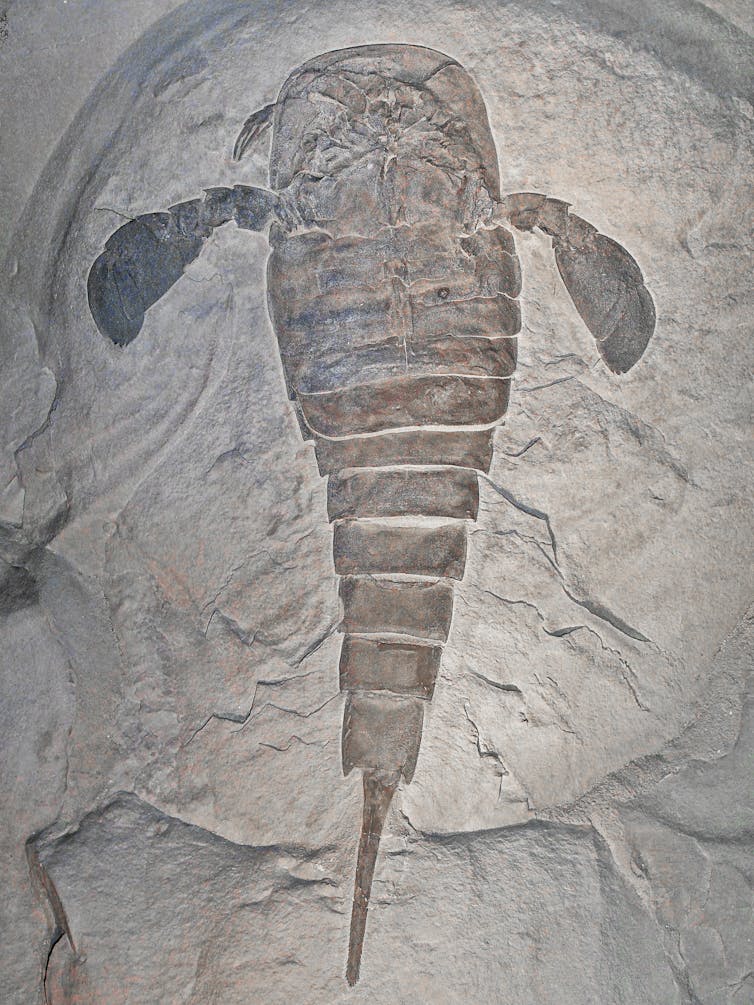
A Sight To Behold
Although Eurypterida looked broadly like scorpions (with a similar body shape, albeit built for swimming), they were not. They were more like the cousins of modern scorpions.
An exceptional part of the sea scorpion evolutionary story is how they fit into the narrative of Paleozoic gigantism.
Read more: Fossils of huge plankton-eating sea creature shine light on early arthropod evolution
Sea scorpions include the largest marine predators to have ever arisen in the fossil record, including one species thought to have been more than 2.5 metres long, Jaekelopterus rhenaniae. Back then, some of these giants were effectively in the same place in their food web as the modern great white shark.
These likely agile swimmers would have used their large front limbs, armed with claws, to grab their prey, which they would then crush between the teeth-like structures on their legs (called gnathobasic spines).
While we’re not sure exactly what these large animals ate, it’s likely fish and smaller arthropods would have been on the menu. And if humans had been around swimming in the sea, maybe us too!
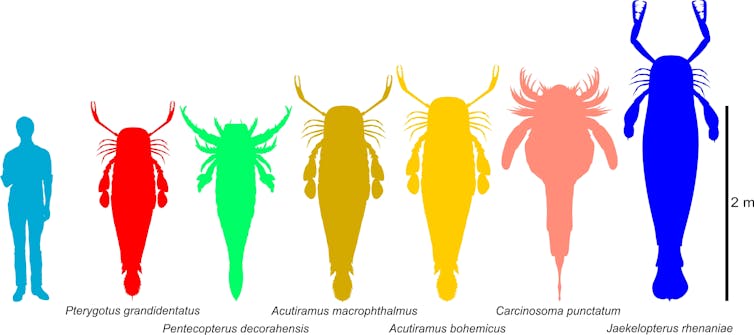
A Fascinating (But Murky) History
Australia is famous for its array of curious animals, including unique modern species such as the platypus. And this uniqueness extends far into the fossil record, with sea scorpions being a case in point.
But the scientific record and study of Australian sea scorpions has been patchy. The first documented specimen, published in 1899, consisted of a fragmented exoskeleton section found in Melbourne.
Prior to our new research examining the completeness of the group in Australia, there were about ten records – and only one other attempt to pool everything together. As such, the diversity and spread of these fossils was fairly uncertain.
For us, revisiting these amazing fossils resulted in a few trips to different Australian museums. We also had specimens sent to us at the University of New England to examine in person.
Read more: The mighty dinosaurs were bugged by other critters
This journey of palaeontological discovery uncovered many sea scorpion fossils than hadn’t previously been noted. As a result, we now have evidence of a possible six different groups that existed in Australia.
Collating these specimens together in our most recent publication, we illustrate the Pterygotidae (the family of sea scorpions that reached 2.5 metres long) dominated the group’s Australian fossil record. Although this had been noted before, the abundance of material from different locations and time periods, especially from Victoria, was unexpected.
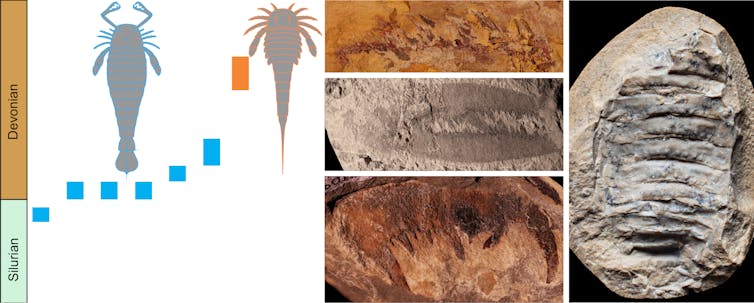
Back To The Source
Besides showcasing the largest number of Australian sea scorpions, our paper also outlines the overall lack of information on these animals.
Despite there being much fragmented material, there is only one (mostly) complete specimen, Adelophthalmus waterstoni, measuring just 5.7cm long.
Future research will involve revisiting the sites where these specimens were originally collected, in the hope of finding more complete specimens. Not only will this help document Australian sea scorpion species better, it will also allow for a more complete understanding of the environments in which they lived.
Ultimately, one thing is clear – there is much left to uncover about these titans that swam through Australia’s prehistoric oceans.
The authors thank Natalie Schroeder of the Commonwealth Palaeontology Collection for her help with this project.![]()
Russell Dean Christopher Bicknell, Post-doctoral researcher in Palaeobiology , University of New England and Patrick Mark Smith, Technical Officer - Palaentology, Australian Museum
This article is republished from The Conversation under a Creative Commons license. Read the original article.
Please Help Sydney Wildlife Rescue: Donate Your Cans And Bottles And Nominate SW As Recipient
You can Help Sydney Wildlife help Wildlife. Sydney Wildlife Rescue is now listed as a charity partner on the return and earn machines in these locations:
- Pittwater RSL Mona Vale
- Northern Beaches Indoor Sports Centre NBISC Warriewood
- Woolworths Balgowlah
- Belrose Super centre
- Coles Manly Vale
- Westfield Warringah Mall
- Strathfield Council Carpark
- Paddy's Markets Flemington Homebush West
- Woolworths Homebush West
- Bondi Campbell pde behind Beach Pavilion
- Westfield Bondi Junction car park level 2 eastern end Woolworths side under ramp
- UNSW Kensington
- Enviro Pak McEvoy street Alexandria.
Every bottle, can, or eligible container that is returned could be 10c donated to Sydney Wildlife.
Every item returned will make a difference by removing these items from landfill and raising funds for our 100% volunteer wildlife carers. All funds raised go to support wildlife.
It is easy to DONATE, just feed the items into the machine select DONATE and choose Sydney Wildlife Rescue. The SW initiative runs until August 23rd.
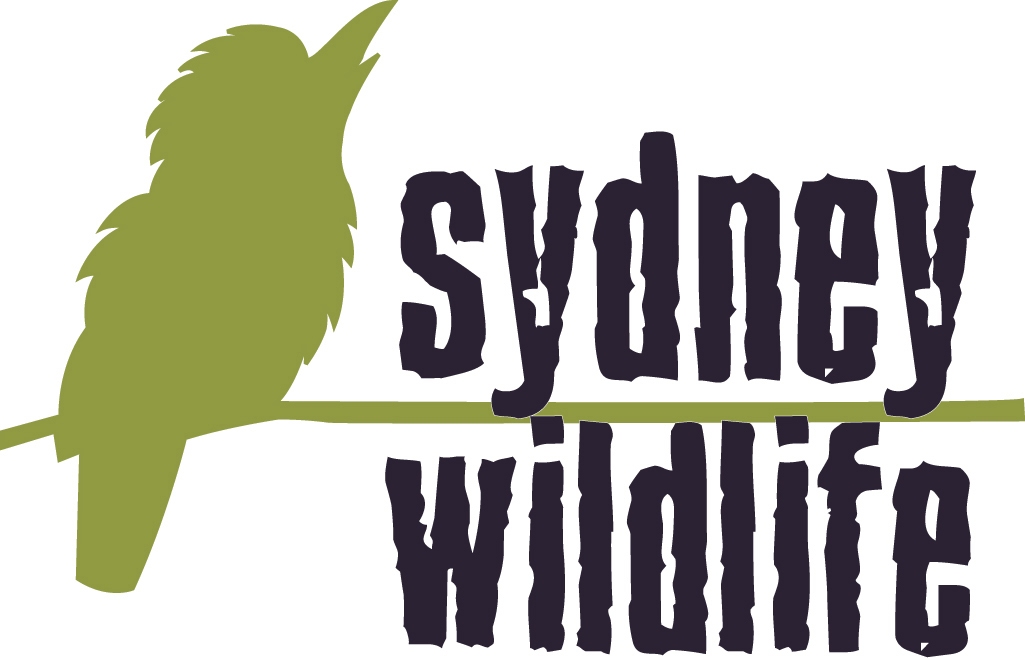
Rat Poisons Are Killing Our Wildlife: Alternatives
BirdLife Australia is currently running a campaign highlighting the devastation being caused by poison to our wildlife. Rodentcides are an acknowledged but under-researched source of threat to many Aussie birds. If you missed BirdLife's rodenticide talk but would like to know more, share data and comment on the use of rodenticides in Australia please visit: https://www.actforbirds.org/ratpoison
Owls, kites and other birds of prey are dying from eating rats and mice that have ingested Second Generation rodent poisons. These household products – including Talon, Fast Action RatSak and The Big Cheese Fast Action brand rat and mice bait – have been banned from general public sale in the US, Canada and EU, but are available from supermarkets throughout Australia.
Australia is reviewing the use of these dangerous chemicals right now and you can make a submission to help get them off supermarket shelves and make sure only licenced operators can use them.
There are alternatives for household rodent control – find out more about the impacts of rat poison on our birds of prey and what you can do at the link above and by reading the information below.
Let’s get rat poison out of bird food chains.
The Australian Pesticides and Veterinary Medicines Authority (APVMA) – is currently asking Australians for their views on how rodent poisons are regulated.
Have your say by making a submission here.
Powerful Owl at Clareville - photo by Paul Wheeler
Pesticides that are designed to control pests such as mice and rats cane also kill our wildlife through either primary or secondary poisoning. Insecticides include pesticides (substances used to kill insects), rodenticides (substances used to kill rodents, such as rat poison), molluscicides (substances used to kill molluscs, such as snail baits), and herbicides (substances used to kill weeds).
Primary poisoning occurs when an animal ingests a pesticide directly – for example, a brushtail possum or antechinus eating rat bait. Secondary poisoning occurs when an animal eats another animal that has itself ingested a pesticide – for example, a greater sooty owl eating a rate that has been poisoned or an antechinus that had eaten rat bait.
Rodenticides are the most common and harmful pesticides to Australian wildlife. Though no comprehensive monitoring of non-target exposure of rodenticides has been conducted, numerous studies have documented the harm rodenticides do to native animals. In 2018, an Australian study found that anticoagulant rodenticides in particular are implicated in non-target wildlife poisoning in Australia, and warned Australia’s usage patterns and lax regulations “may increase the risk of non-target poisoning”.
Most rodenticides work by disrupting the normal coagulation (blood clotting) process, and are classified as either “first generation” / “multiple dose” or “second generation” / “single dose”, depending on how many doses are required for the poison to be lethal.
These anticoagulant rodenticides cause victims of anticoagulant rodenticides to suffer greatly before dying, as they work by inhibiting Vitamin K in the body, therefore disrupting the normal coagulation process. This results in poisoned animals suffering from uncontrolled bleeding or haemorrhaging, either spontaneously or from cuts or scratches. In the case of internally haemorrhaging, which is difficult to spot, the only sign of poisoning is that the animal is weak, or (occasionally) bleeding from the nose or mouth. Affected wildlife are also more likely to crash into structures and vehicles, and be killed by predators.
An animal has to eat a first generation rodenticide (e.g. warfarin, pindone, chlorophaninone, diphacinone) more than once in order to obtain a lethal dose. For this reason, second generation rodenticides (e.g. difenacoum, brodifacoum, bromadiolone and difethialone) are the most commonly used rodenticides. Second generation rodenticides only require a single dose to be consumed in order to be lethal, yet kill the animal slowly, meaning the animal keeps coming back. This results in the animal consuming many times more poison than a single lethal dose over the multiple days it takes them to die, during which time they are easy but lethal prey to predators. This is why second generation poisons tend to be much more acutely toxic to non-target wildlife, as they are much more likely to bioaccumulate and biomagnify, and clear very slowly from the body.
Species most at risk from poisons
Small Mammals
Small mammals including possums and bandicoots often consume poisons such as snail bait, or rat bait that has been laid out to attract and kill rats, mice, and rabbits. Poisons such as pindone are often added to oats or carrots, and lead to a slow, painful death of internal bleeding. Australian possums often consume rat bait such as warfarin, which causes extensive internal bleeding, usually resulting in death.
There is a very poor chance of survival. Possums are also known to consume slug bait, which results in a prolonged painful death mainly from neurological effects. There is no treatment.
Small mammals can also be poisoned by insecticides. Possums, for example, can ingest these poisons when consuming fruit from a tree that has been sprayed with insecticide. Rescued by a WIRES carer, the brushtail possum joey pictured below was suffering from suspected insecticide poisoning. Though coughing up blood, luckily the joey did not ingest a lethal dose as he survived in care and was later released.
Large Mammals
Despite their size, large mammals including wallabies, kangaroos and wombats can also fall victim to pesticide poisoning. Wallabies and kangaroos have been known to suffer from rodenticide poisoning, while poisons often ingested by wombats include rat bait from farm sheds, and sodium fluroacetate (1080) laid out to kill pests such as cats and foxes.
Australian mammals are also impacted by the use of insecticides. DDT, although a banned substance, has been reported as killing marsupials.
Birds
Birds have a high metabolic rate and therefore succumb quickly to poisons. Australian birds of prey – owls (such as the southern boobook) and diurnal raptors (such as kestrels) – can be killed by internal bleeding when they eat rodents that have ingested rat bait. A 2018 Western Australian study determined that 73% of southern boobook owls found dead or were found to have anticoagulant rodenticides in their systems, and that raptors with larger home ranges and more mammal-based diets may be at a greater risk of anticoagulant rodenticide exposure.
Insectivorous birds will often eat insects sprayed with insecticides, and a few different species of birds may be affected at the same time. Unfortunately little can be done and death most often results.
Organophosphates are the most widely used insecticide in Australia. Birds are very susceptible to organophosphates, which are nerve toxins that damage the nervous system, with poisoning occurring through the skin, inhalation, and ingestion. Organophosphates can cause secondary poisoning in wild birds which ingest sprayed insects. Often various species of insectivorous birds are affected at the same time as they come down to eat the dying insects. After a bird is poisoned, death usually occurs rapidly. Raptors have also been deliberately or inadvertently poisoned when organophosphates have been applied to a carcass to poison crows.
Organochlorine pesticides (OCPs) are persistent, bio-accumulative pesticides that include DDT, dieldrin, heptachlor and chlordane. OPC’s have been used extensively in the agriculture industry since the 1940s. Some of the more common product names include Hortico Dieldrin Dust, Shell Dieldrex and Yates Garden Dust. Although no OCP’s are currently registered for use in the home environment in Australia, many of these products still remain in use on farms, in business premises and households. OCP poisons remain highly toxic in the environment for many years impacting on humans, animals, birds and especially aquatic life. They can have serious short-term and long-term impacts at low concentrations. In addition, non-lethal effects such as immune system and reproductive damage of some of these pesticides may also be significant. Birds are particularly sensitive to these pesticides, and there have even been occasions where the deliberate poisoning of birds has occurred. Tawny frogmouths are most often poisoned with OCP’s. The poisons are stored in fat deposits and gradually increase over time. At times of food scarcity, or during any stressful period, such as breeding season or any changes to their environment, the fat stores are metabolised, and with it, the poison load in their blood streams reaches acute levels, causing death.
Although herbicides, or weed killers, are designed to kill plants, some are toxic to birds. Common herbicide glyphosate (Roundup) will cause severe eye irritation in birds if they come into contact with the spray. Herbicides also have the impact of removing food plants that birds, or their insect food supply, rely on. Birds can also readily fall victim to snail baits, either via primary or secondary poisoning.
Reptiles and Amphibians
As vertebrate species, reptiles and amphibians are also at risk of pesticides. Though less is known about the effects of pesticides on reptiles and amphibians, these animals have been known to fall victim to pesticide poisoning. Blue-tongue lizards, for example, often consume rat bait and die of internal bleeding. A 2018 Australian study also found that reptiles may be important vectors (transporters) of rodenticides in Australia.
How to keep pests away and keep wildlife safe
Remember, pesticides are formulated to be tasty and alluring to the target species, but other species find them enticing, too. It is safest for wildlife, pets and people for us to not use any pesticides, and prevent or deter the presence of pests practically, rather than attempt to eliminate them chemically.
Tips to prevent and deter wildlife deaths from poisoning:
- Deter rats and mice around your property by simply cleaning up; removing rubbish, keeping animal feed well contained and indoors, picking up fallen fruits and vegetation, and using chicken feeders removes potential food sources.
- Seal up holes and in your walls and roof to reduce the amount of rodent-friendly habitat in your house.
- Replace palms with native trees; palm trees are a favourite hideout for black rats, while native trees provide ideal habitat for native predators like owls and hawks which help to control rodent populations.
- Set traps with care in a safe, covered spot, away from the reach of children, pets and wildlife. Two of the most effective yet safe baits are peanut butter and pumpkin seeds.
- To control slugs, terracotta or ceramic plant pots can be placed upside down in the garden or aviary. Slugs and snails will seek the dark, damp area this creates, and can be collected daily. They can then be drowned in a jar of soapy water. You can also sink a jar or dish into the soil and fill it with beer. The slugs are attracted to the yeast in the beer, fall in and then drown.
If turning to pesticides as a last resort:
- Use only animal-safe slug baits.
- Place tamper-proof bait stations out of reach of wildlife.
- Avoid using loose whether pellets or poison grain, present the highest risk, the latter being particularly attractive to seed-eating birds and to many small mammal species.
- Read the label and use as instructed.
- Avoid products containing second generation products difenacoum, brodifacoum, bromadiolone and difethialone, which are long-lasting and much more likely to unintentionally poison wildlife via secondary poisoning.
- Cover individual fruits when spraying fruit trees with insecticides.
Poisons kill dogs too
Because of their poisonous nature, pesticides pose a risk to animals and people alike, including pets and children. Roaming pets like cats and dogs are most at risk of being poisoned, with one 2016 study at the Norwegian University of Life Sciences finding that one in five dogs had rat poison in its body, and a 2011 study by the Humane Society in the United States finding that 74% of their pet poisoning cases are due to second-generation anticoagulants such as rat baits.
It is best to avoid the use of all pesticides, or otherwise use them sparingly, carefully and only after researching each poison and its correct usage. Always supervise pets and children, keep poisons locked out of their reach, and be vigilant in public spaces where pesticides may have accumulated, e.g. poisons can accumulate in streams or puddles where herbicides have recently been sprayed.
If you suspect your pet has been poisoned, seek veterinary help immediately.
If you suspect your child or another adult has been poisoned, do not induce vomiting and call the NSW Poisons Information Centre on 13 11 26 for 24/7 medical advice, Australia-wide.
References
Lohr, M. T. & Davis, R. A. 2018, Anticoagulant rodenticide use, non-target impacts and regulation: A case study from Australia, Science of The Total Environment, vol. 634, pp. 1372-1384.
Lohr, M. T. 2018, Anticoagulant rodenticide exposure in an Australian predatory bird increases with proximity to developed habitat, Science of The Total Environment, Volume 643, pp.134-144.
Lohr, M. T. 2018, Anticoagulant Rodenticides: Implications for Wildlife Rehabilitation, conference paper, Australian Wildlife Rehabiliation Conference, awrc.org.au
Olerud, S., Pedersen, J. & Kull, E. P. 2009, Prevalence of superwarfarins in dogs – a survey of background levels in liver samples of autopsied dogs. Norwegian University of Life Sciences, Faculty of Veterinary Medicine and Life Sciences, Department of Sports and Family Animal Medicine, Section for Small Animal Diseases.
Healthy Wildlife, Healthy Lives, 2017, Rodenticides and Wildlife, healthywildlife.com.au
Society for the Preservation of Raptors Inc. 2019, Raptor Fact Sheet: Eliminate Rats and Mice, Not Wildlife!, raptor.org.au/factsheetpests.pdf
W.I.R.E.S. Poisons and baits don't just kill rats.
.jpg?timestamp=1590728675788)
Barking Owl (Ninox connivens connivens)- photo by Julie Edgley - this nocturnal animal will eat mice and so become a victim of poisons through them
Echidna Season
Echidna season has begun. As cooler days approach, our beautiful echidnas are more active during the days as they come out to forage for food and find a mate. This sadly results in a HIGH number of vehicle hits.
What to do if you find an Echidna on the road?
- Safely remove the Echidna off the road (providing its safe to do so).
- Call Sydney Wildlife or WIRES
- Search the surrounding area for a puggle (baby echidna). The impact from a vehicle incident can cause a puggle to roll long distances from mum, so please search for these babies, they can look like a pinky-grey clump of clay
What to do if you find an echidna in your yard?
- Leave the Echidna alone, remove the threat (usually a family pet) and let the Echidna move away in it's own time. It will move along when it doesn't feel threatened.
If you find an injured echidna or one in an undesirable location, please call Sydney Wildlife on 9413 4300 for advice.
www.sydneywildlife.org.au
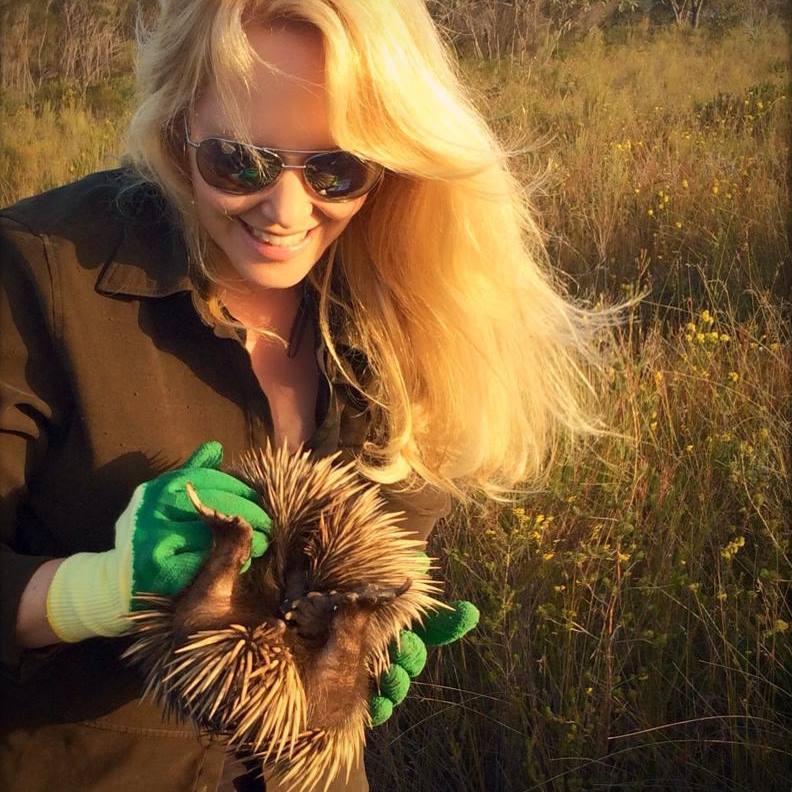
Lynleigh Greig, Sydney Wildlife, with a rescued echidna being returned to its home
The Extraordinary 1919 Torres Strait Cruise Of The RSYS Yawl 'Stormy Petrel'
Marine Algae From The Kiel Fjord Discovered As A Remedy Against Infections And Skin Cancer
Olive And Mabel - Behind The Scenes
BirdLife Australia 2020 Photo Comp
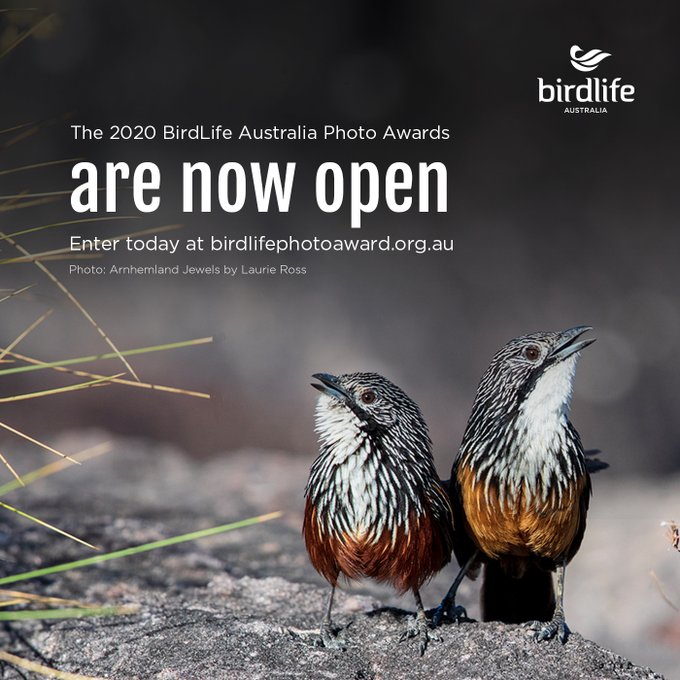
Snowy Waters
AVPALS Online Seminars
 Avpals are pleased to announce the development of our online training programs. These commenced in April 2020. A variety of subjects are covered and are entirely free.
Avpals are pleased to announce the development of our online training programs. These commenced in April 2020. A variety of subjects are covered and are entirely free. Older Persons Advocacy Network (OPAN)
Our Regular Reviews May Increase Your Payment Rate
Self-Funded Retirees Act Now – Don’t Miss Out On Final $750 Stimulus Payment
- access to cheaper medicine under the Pharmaceutical Benefits Scheme,
- the chance to be bulk billed by a GP (at their discretion),
- a bigger refund on medical costs when you reach the Medicare Safety Net, and
- access to some state and territory concessions
How To Make Watercolour Postcards With Jumaadi
Published July 3, 2020 by the Art Gallery of NSW
Jumaadi wants to see your art! Together In Art Kids and Jumaadi are inviting primary school aged children to create artworks inspired by someone, something or somewhere special to them. Entries must be received by 5pm, Sunday 12 July – see www.togetherinart.org/kids for how to submit.
Step inside the studio of Sydney artist Jumaadi and be inspired to make watercolour postcards for your friends and loved ones. Filming from Eora Country, Jumaadi shares his tips and techniques for using watercolours to record memories of special people and special places.
What Do Seals Eat?
Published by Taronga Zoo
Live streaming of animals still available visit: https://www.youtube.com/user/TarongaSydney/featured
Curious Kids: what does the Sun's core look like?
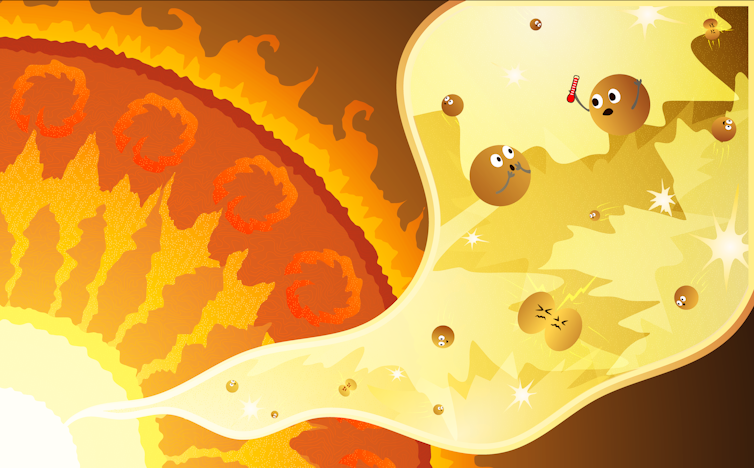
What does the Sun’s core look like? Sophie, aged 8, Perth
What does the Sun’s core look like? This is a fantastic question Sophie, and one we will need to go on an adventure to answer!
We are about to take a journey to the centre of the Sun. The action begins about 148 million kilometres from our planet when we arrive at the Sun’s surface in our space ship.
It’s hot here at the surface, about 5,700 degrees Celsius, and the light is brilliant and blinding. As we look closer, the surface appears to bubble, just like boiling water. Some of the bubbles look darker than the others. The darker bubbles are slightly cooler than the rest, but every inch of the surface is still blisteringly hot.
Read more: Curious Kids: how are stars made?
From Zone To Zone
We continue on our journey, diving through one of these giant bubbles on the surface, and head towards our first stop: the convective zone.
Surrounding us is a hot fluid called plasma, filled with bubbles by the constant movement of hot gases rising and cool gases falling. The bubbles are moving, growing and shrinking. Some are even popping as our space ship travels down further, rocking from side to side like a boat in a high sea.
After travelling down for 200,000 kilometres (that’s about 15 times the width of the whole Earth!) the rocking finally stops. We’ve made it to our second stop, the radiative zone.
This part of the Sun is very hot. It is now 2 million degrees outside our space ship. If we could see individual light particles, called photons, we’d see them bouncing between the tiny particles, called atoms, that make up the plasma.
These bounces forwards and backwards and from side to side make up a dance scientists call a “random walk”. It can take one photon hundreds of thousands of years to randomly walk its way out of this layer.
Our spaceship is going full speed ahead, so we move through it much more quickly.
The weight of all the plasma above us pressing down means the plasma around us is denser than gold, and the temperatures are soaring up towards 15 million degrees! We have almost reached the final stop on our tour, the Sun’s core.
Read more: Curious Kids: Why do stars twinkle?
Welcome To The Core
Before we enter the core, we’re going to have to shrink down to the size of an atom. It is the only way we will get to see what is happening in here, because what we are trying to see in here is atoms, millions of times smaller than a grain of sand!
The core of the Sun is home to billions and billions of atoms of hydrogen, the lightest element in the universe. The immense pressure and heat pushes these atoms so close to one another that they squish together to create new, heavier atoms.
This is called nuclear fusion. The hydrogen atoms that get squished together form an entirely different substance called helium.

So now that we are in the core of the Sun, what does it actually look like? Not only is everything blindingly bright, but it just might have a pretty pink colour!
We can’t be entirely sure what the core would look like to human eyes, but we have seen in labs here on Earth that hydrogen plasma has a pink glow. So we can make an educated guess that hydrogen plasma in the core of the Sun would look about the same.
When atoms merge together, they release large amounts of energy in the form of light. The light works its way up through the core, into the radiative zone where it bounces around, until it finally makes it into the convective zone. Then the light travels up to the surface of the Sun through massive bubbles of plasma, and from the surface it is free to travel uninterrupted through the sky.
It’s time to leave the hottest place in our solar system and head back to Earth. Our journey has taken us 700,000 kilometres deep into the interior of the Sun, past the bubbles of the convective zone, through the billions of the light rays in the radiative zone and into the mysterious atom-fusing core.
As we land back on Earth and look towards the Sun in the sky, it’s almost like looking back in time. We know now the light we are seeing was created hundreds of thousands of years ago, in the hottest place in the Solar system!![]()
Sara Webb, PhD candidate in Astrophysics, Swinburne University of Technology
This article is republished from The Conversation under a Creative Commons license. Read the original article.
Book Of The Month: July 2020 - Once Upon A Time In The Kitchen: Recipes And Tales From Classic Children's Stories
by Carol Odell, Publication date 2010

New Shorebird Identification Booklet
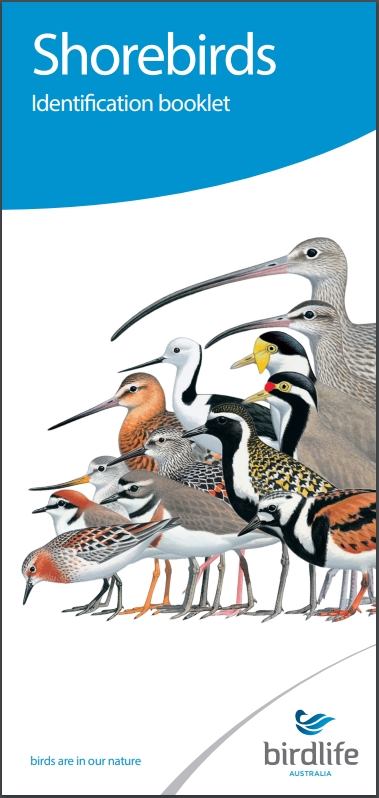 The Migratory Shorebird Program has just released the third edition of its hugely popular Shorebird Identification Booklet. The team has thoroughly revised and updated this pocket-sized companion for all shorebird counters and interested birders, with lots of useful information on our most common shorebirds, key identification features, sighting distribution maps and short articles on some of BirdLife’s shorebird activities.
The Migratory Shorebird Program has just released the third edition of its hugely popular Shorebird Identification Booklet. The team has thoroughly revised and updated this pocket-sized companion for all shorebird counters and interested birders, with lots of useful information on our most common shorebirds, key identification features, sighting distribution maps and short articles on some of BirdLife’s shorebird activities.
The booklet can be downloaded here in PDF file format: http://www.birdlife.org.au/documents/Shorebird_ID_Booklet_V3.pdf
Paper copies can be ordered as well, see http://www.birdlife.org.au/projects/shorebirds-2020/counter-resources for details.
Download BirdLife Australia's children’s education kit to help them learn more about our wading birdlife
Shorebirds are a group of wading birds that can be found feeding on swamps, tidal mudflats, estuaries, beaches and open country. For many people, shorebirds are just those brown birds feeding a long way out on the mud but they are actually a remarkably diverse collection of birds including stilts, sandpipers, snipe, curlews, godwits, plovers and oystercatchers. Each species is superbly adapted to suit its preferred habitat. The Red-necked Stint is as small as a sparrow, with relatively short legs and bill that it pecks food from the surface of the mud with, whereas the Eastern Curlew is over two feet long with a exceptionally long legs and a massively curved beak that it thrusts deep down into the mud to pull out crabs, worms and other creatures hidden below the surface.
Some shorebirds are fairly drab in plumage, especially when they are visiting Australia in their non-breeding season, but when they migrate to their Arctic nesting grounds, they develop a vibrant flush of bright colours to attract a mate. We have 37 types of shorebirds that annually migrate to Australia on some of the most lengthy and arduous journeys in the animal kingdom, but there are also 18 shorebirds that call Australia home all year round.
What all our shorebirds have in common—be they large or small, seasoned traveller or homebody, brightly coloured or in muted tones—is that each species needs adequate safe areas where they can successfully feed and breed.
The National Shorebird Monitoring Program is managed and supported by BirdLife Australia.
This project is supported by Glenelg Hopkins Catchment Management Authority and Hunter Local Land Services through funding from the Australian Government’s National Landcare Program. Funding from Helen Macpherson Smith Trust and Port Phillip Bay Fund is acknowledged.
The National Shorebird Monitoring Program is made possible with the help of over 1,600 volunteers working in coastal and inland habitats all over Australia.
The National Shorebird Monitoring program (started as the Shorebirds 2020 project initiated to re-invigorate monitoring around Australia) is raising awareness of how incredible shorebirds are, and actively engaging the community to participate in gathering information needed to conserve shorebirds.
In the short term, the destruction of tidal ecosystems will need to be stopped, and our program is designed to strengthen the case for protecting these important habitats.
In the long term, there will be a need to mitigate against the likely effects of climate change on a species that travels across the entire range of latitudes where impacts are likely.
The identification and protection of critical areas for shorebirds will need to continue in order to guard against the potential threats associated with habitats in close proximity to nearly half the human population.
Here in Australia, the place where these birds grow up and spend most of their lives, continued monitoring is necessary to inform the best management practice to maintain shorebird populations.
BirdLife Australia believe that we can help secure a brighter future for these remarkable birds by educating stakeholders, gathering information on how and why shorebird populations are changing, and working to grow the community of people who care about shorebirds.
To find out more visit: http://www.birdlife.org.au/projects/shorebirds-2020/shorebirds-2020-program
How To Make A Photo Mosaic With Artist Khaled Sabsabi
Published by the Art Gallery of NSW
What's the meaning of life? These students have some answers

Research has found people who have clarity around what provides meaning in their lives tend to be happier, healthier, more satisfied with life and resilient in the face of adversity.
Given the dramatic growth in mental health issues, particularly in young people, researchers have recently tried to more deeply understand what gives young people’s lives meaning.
We conducted a research project with 174 students in year seven, where they used photographs to show what was important to them. We found relationships – with friends, family and pets – were what they most believed gave meaning to their life.
Using The Mind’s Eye
A 2013 study in the US explored the meaning of life for college students using what the researchers called “the mind’s eye” technique.
Researchers asked college students to take photos of things that made their lives meaningful and write a short narrative to describe them. The photographs became a record of meaning-in-life sources. The most common photos were of relationships, hobbies and activities, and nature.
The research method also provided a personalised view on why students chose these images.
We used the same approach in an Australian secondary school to determine what gave 174 year seven students meaning in life – at school and outside of it.
The students took two photos each – of what provides meaning in life at school and out of school – and wrote why they had chosen these images.
Meaning In Life, At School

Students took a variety of images. But overwhelmingly they identified friends as the main source of meaning in life at school, followed by their own learning.
This word cloud highlights the most commonly used words in the students’ narratives, and shows how important friends are in young peoples’ school lives.

Students suggested their friends not only provided meaning because they were fun to be with and shared common interests, but because they provided support as they tackled the challenges of high school.
Of the 151 images devoted to friendships, 31 of the accompanying narratives used the term “they’re always there for me”, suggesting these friendships were built on commitment and emotional support.
One student said friends
give my life meaning because if I didn’t have them I wouldn’t be the person I am now. Friends are people you learn from, they’re like fun teachers. They teach us what to do and what not to do.
Another student described her friends as inspirational
[…] they give my life meaning because they are always there to help me and inspire me to do great things. They are positive people who don’t bring me down – they make me feel better about myself.
Meaning In Life, Outside School
Students continued the theme of relationships when talking about the sources of meaning in their lives outside school. Their three main sources of meaning were sport, family and pets.
The selection of sport for both boys and girls appeared based more on the friendships in these settings, rather than the sport itself.
For example, this student took a photo of her trophies to represent netball, but said it was “the people you get to meet and the things you get to do that make it meaningful”.

Students also found meaning in life from their families. They consistently expressed the importance of being cared for and supported. It was clear that love and togetherness gave their young lives coherence.
Simple things were telling. One student wrote of their family:
[…] they give my life meaning because they love me, accept me and help me thorough the tough times.
Students also saw pets as part of the family and a strong source of meaning in life. Given students’ desire for loyalty and consistency from their friends, it was not surprising the uncomplicated relationships with pets were so important.
One student wrote:
This is a photo of my dog[…] She gives my life meaning because I love her, and love walking, playing and taking care of her. She is like a sister to me.
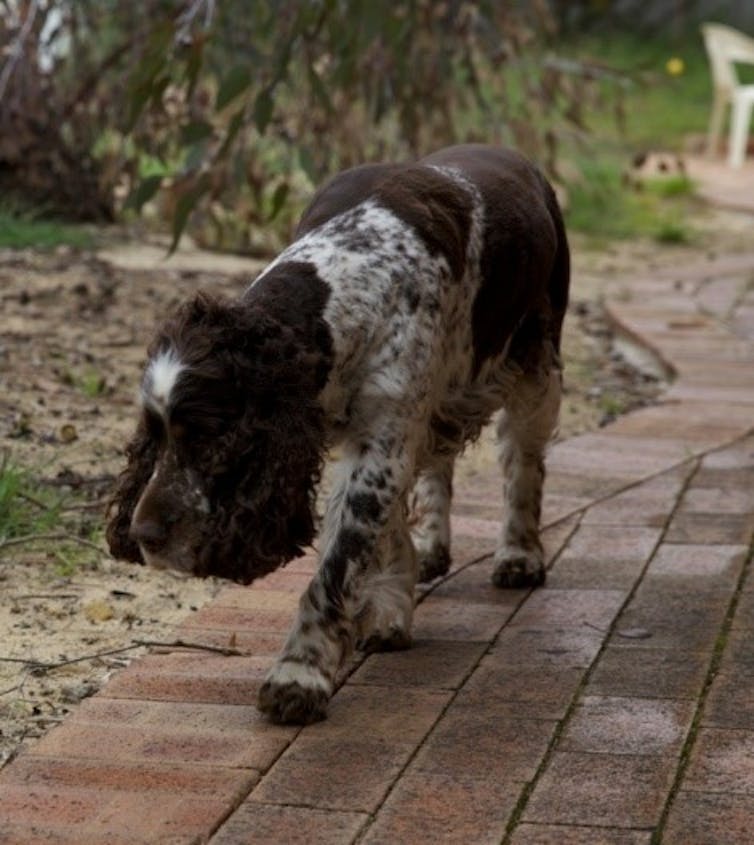
Others enjoyed creative pursuits. One student took a photo of herself singing and said:
It gives my life meaning because I love to do it, it’s fun and helps me to dream big for the future ahead.
While schools keep a careful eye on their students’ learning, it’s important they ensure academic growth is aligned with meaning and purpose.
Practical research interventions such as the minds-eye can provide schools with a sense of what gives their students meaning. This can direct programs and tailor support around nurturing these sources, and let students “dream big for the future”.![]()
John O'Rourke, Senior lecturer, Edith Cowan University
This article is republished from The Conversation under a Creative Commons license. Read the original article.
Portrait of Hemi Pomara as a young man: how we uncovered the oldest surviving photograph of a Māori

It is little wonder the life of Hemi Pomara has attracted the attention of writers and film makers. Kidnapped in the early 1840s, passed from person to person, displayed in London and ultimately abandoned, it is a story of indigenous survival and resilience for our times.
Hemi has already been the basis for the character James Pōneke in New Zealand author Tina Makereti’s 2018 novel The Imaginary Lives of James Pōneke. And last week, celebrated New Zealand director Taika Waititi announced his production company Piki Films is adapting the book for the big screen – one of three forthcoming projects about colonisation with “indigenous voices at the centre”.
Until now, though, we have only been able to see Hemi’s young face in an embellished watercolour portrait made by the impresario artist George French Angas, or in a stiff woodcut reproduced in the Illustrated London News.
Drawing on the research for our forthcoming book, Empire, Early Photography and Spectacle: the global career of showman daguerreotypist J.W. Newland (Routledge, November 2020), we can now add the discovery of a previously unknown photograph of Hemi Pomara posing in London in 1846.
This remarkable daguerreotype shows a wistful young man, far from home, wearing the traditional korowai (cloak) of his chiefly rank. It was almost certainly made by Antoine Claudet, one of the most important figures in the history of early photography.
All the evidence now suggests the image is not only the oldest surviving photograph of Hemi, but also most probably the oldest surviving photographic portrait of any Māori person. Until now, a portrait of Caroline and Sarah Barrett taken around 1853 was thought to be the oldest such image.
For decades this unique image has sat unattributed in the National Library of Australia. It is now time to connect it with the other portraits of Hemi, his biography and the wider conversation about indigenous lives during the imperial age.
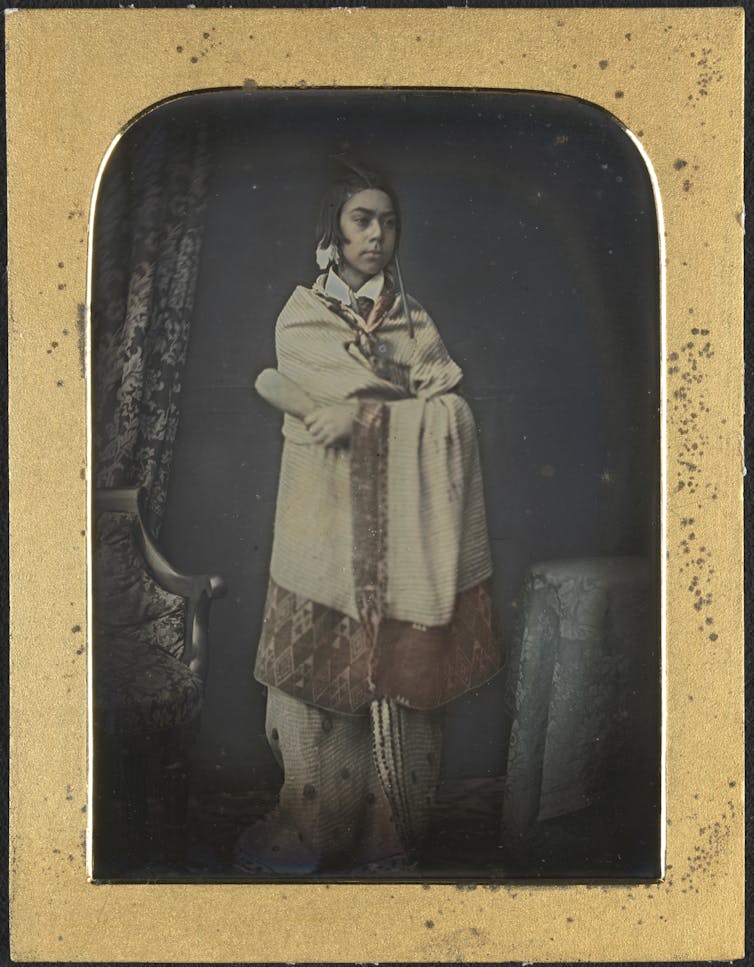
A Boy Abroad
Hemi Pomara led an extraordinary life. Born around 1830, he was the grandson of the chief Pomara from the remote Chatham Islands off the east coast of New Zealand. After his family was murdered during his childhood by an invading Māori group, Hemi was seized by a British trader who brought him to Sydney in the early 1840s and placed him in an English boarding school.
The British itinerant artist, George French Angas had travelled through New Zealand for three months in 1844, completing sketches and watercolours and plundering cultural artefacts. His next stop was Sydney where he encountered Hemi and took “guardianship” of him while giving illustrated lectures across New South Wales and South Australia.
Angas painted Hemi for the expanded version of this lecture series, Illustrations of the Natives and Scenery of Australia and New Zealand together with 300 portraits from life of the principal Chiefs, with their Families.
In this full-length depiction, the young man appears doe-eyed and cheerful. Hemi’s juvenile form is almost entirely shrouded in a white, elaborately trimmed korowai befitting his chiefly ancestry.
The collar of a white shirt, the cuffs of white pants and neat black shoes peak out from the otherwise enveloping garment. Hemi is portrayed as an idealised colonial subject, civilised yet innocent, regal yet complacent.
Read more: To build social cohesion, our screens need to show the same diversity of faces we see on the street
Angas travelled back to London in early 1846, taking with him his collection of artworks, plundered artefacts – and Hemi Pomara.
Hemi appeared at the British and Foreign Institution, followed by a private audience with Queen Victoria and Prince Albert. From April 1846, he was put on display in his chiefly attire as a living tableau in front of Angas’s watercolours and alongside ethnographic material at the Egyptian Hall, London.
The Egyptian Hall “exhibition” was applauded by the London Spectator as the “most interesting” of the season, and Hemi’s portrait was engraved for the Illustrated London News. Here the slightly older-looking Hemi appears with darkly shaded skin and stands stiffly with a ceremonial staff, a large ornamental tiki around his neck and an upright, feathered headdress.
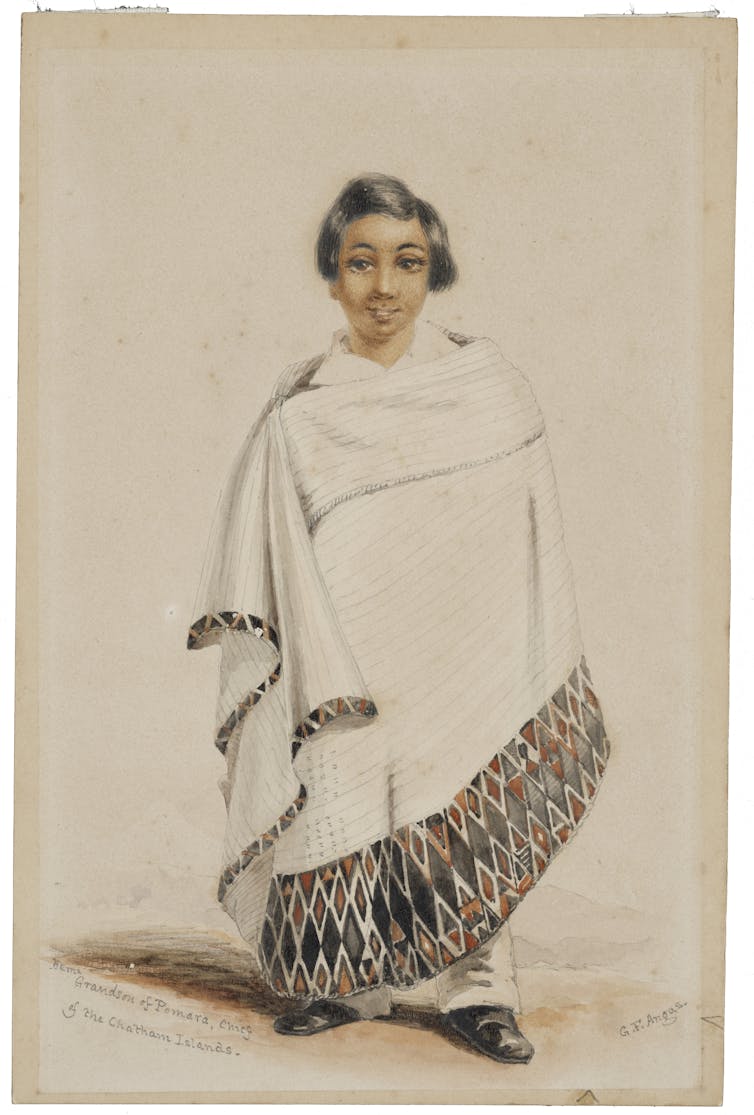
A Photographic Pioneer
Hemi was also presented at a Royal Society meeting which, as The Times recorded on April 6, was attended by scores of people including Charles Dickens, Charles Darwin, and the pioneering London-based French daguerreotypist Antoine Claudet.
It was around this time Claudet probably made the quarter-plate daguerreotype, expertly tinted with colour, of Hemi Pomara in costume.
The daguerreotype was purchased in the 1960s by the pioneering Australian photo historian and advocate for the National Library of Australia’s photography collections, Eric Keast Burke. Although digitised, it has only been partially catalogued and has evaded attribution until now.
Unusually for photographic portraits of this period, Hemi is shown standing full-length, allowing him to model all the features of his korowai. He poses amidst the accoutrements of a metropolitan portrait studio. However, the horizontal line running across the middle of the portrait suggests the daguerreotype was taken against a panelled wall rather than a studio backdrop, possibly at the Royal Society meeting.
Hemi has grown since Angas’s watercolour but the trim at the hem of the korowai is recognisable as the same garment worn in the earlier painting. Its speckled underside also reveals it as the one in the Illustrated London News engraving.
Hemi wears a kuru pounamu (greenstone ear pendant) of considerable value and again indicative of his chiefly status. He holds a patu onewa (short-handled weapon) close to his body and a feathered headdress fans out from underneath his hair.
We closely examined the delicate image, the polished silver plate on which it was photographically formed, and the leatherette case in which it was placed. The daguerreotype has been expertly colour-tinted to accentuate the embroidered edge of the korowai, in the same deep crimson shade it was coloured in Angas’s watercolour.
Read more: Director of science at Kew: it's time to decolonise botanical collections
The remainder of the korowai is subtly coloured with a tan tint. Hemi’s face and hands have a modest amount of skin tone colour applied. Very few practitioners outside Claudet’s studio would have tinted daguerreotypes to this level of realism during photography’s first decade.
Hallmarks stamped into the back of the plate show it was manufactured in England in the mid-1840s. The type of case and mat indicates it was unlikely to have been made by any other photographer in London at the time.
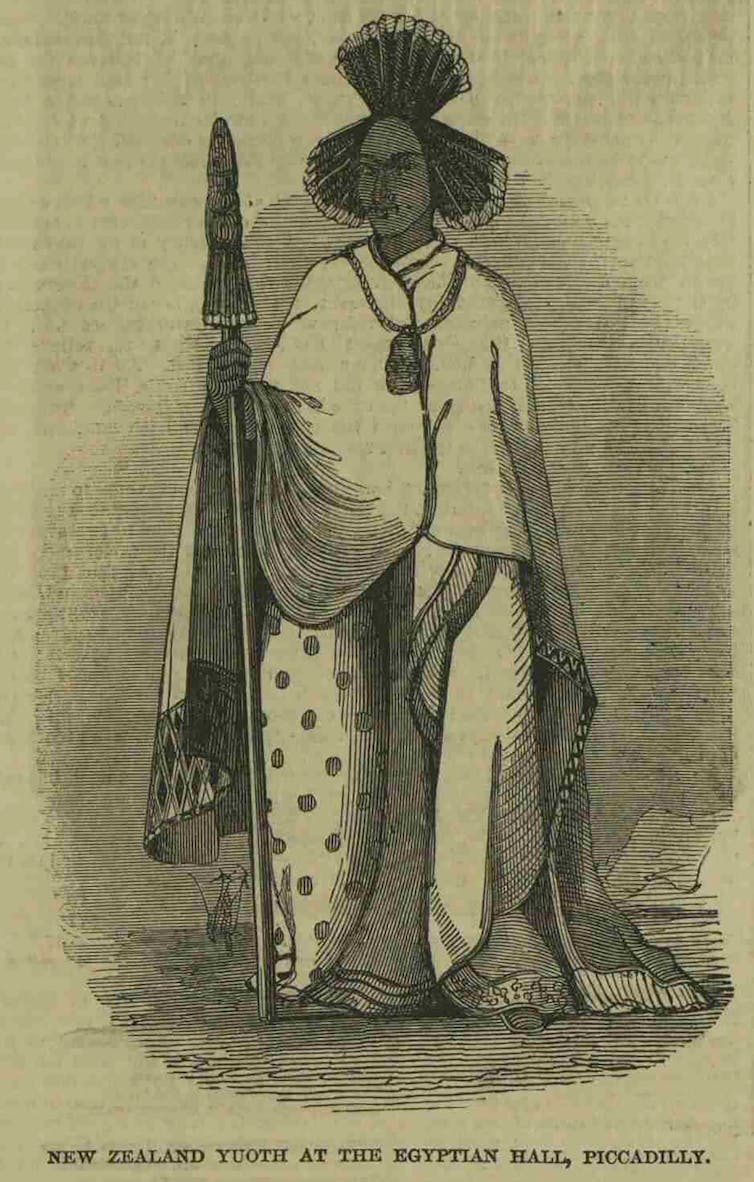
Survival And Resilience
After his brief period as a London “celebrity” Hemi went to sea on the Caleb Angas. He was shipwrecked at Barbados, and on his return aboard the Eliza assaulted by the first mate, who was tried when the ship returned to London. Hemi was transferred into the “care” of Lieutenant Governor Edward John Eyre who chaperoned him back to New Zealand by early December 1846.
Hemi’s story is harder to trace through the historical record after his return to Auckland in early 1847. It’s possible he returned to London as an older married man with his wife and child, and sat for a later carte de visite portrait. But the fact remains, by the age of eighteen he had already been the subject of a suite of colonial portraits made across media and continents.
With the recent urgent debates about how we remember our colonial past, and moves to reclaim indigenous histories, stories such as Hemi Pomara’s are enormously important. They make it clear that even at the height of colonial fetishisation, survival and cultural expression were possible and are still powerfully decipherable today.
For biographers, lives such as Hemi’s can only be excavated by deep and wide-ranging archival research. But much of Hemi’s story still evades official colonial records. As Taika Waititi’s film project suggests, the next layer of interpretation must be driven by indigenous voices.
The authors would like to acknowledge the late Roger Blackley (Victoria University, Wellington), Chanel Clarke (Curator of the Maori collections, Auckland War Memorial Museum), Nat Williams (former Treasures Curator, National Library of Australia), Dr Philip Jones (Senior Curator, South Australian Museum) and Professor Geoffrey Batchen (Professorial chair of History of Art, University of Oxford) for their invaluable help with their research.![]()
Elisa deCourcy, Australian Research Council DECRA Fellow 2020-2023, Research School of Humanities and the Arts, Australian National University, Australian National University and Martyn Jolly, Honorary Associate Professor, School of Art and Design, Research School of Humanities and the Arts, College of Arts and Social Sciences, Australian National University
This article is republished from The Conversation under a Creative Commons license. Read the original article.
Across Five Decades - Photographing The Sydney To Hobart Race
Published by the Royal Sydney Yacht Squadron - more Online Talks available here
The kids are alright: young adult post-disaster novels can teach us about trauma and survival
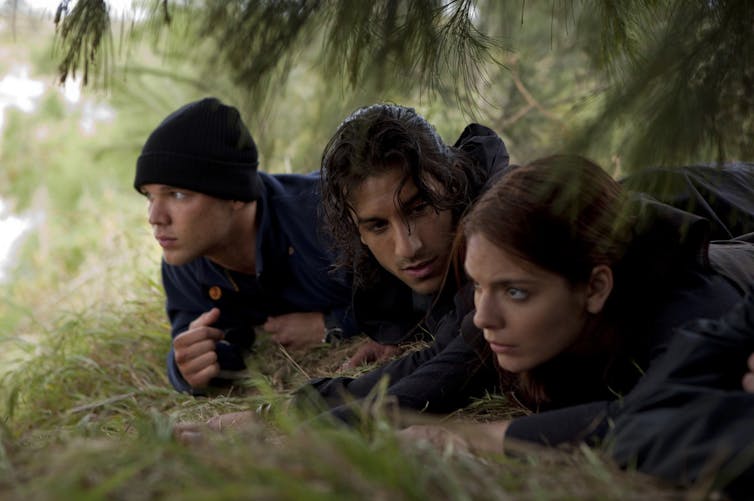
COVID-19 is changing the way we live. Panic buying, goods shortages, lockdown – these are new experiences for most of us. But it’s standard fare for the protagonists of young adult (YA) post-disaster novels.

In Davina Bell’s latest book, The End of the World Is Bigger than Love (2020), a global pandemic, cyberterrorism and climate change are interrelated disasters that have destroyed the world as we know it.
Like most post-disaster novels, the book is more concerned with how we survive rather than understanding the causes of disaster. As such, we can read it to explore our fears, human responses to disaster and our capacity to adapt.
The Day After
Kelly Devos’s Day Zero (2019), and the soon to be released Day One (2020), use cyberterrorism as the disaster. Like Bell’s novel, Day Zero focuses more on how the protagonist, Jinx, maintains her humanity when she must harm or kill others in order to keep herself and her siblings alive.

A form of speculative fiction, YA post-disaster writing imaginatively explores causes and responses to apocalyptic disasters. (Some readers categorise YA juggernaut The Hunger Games – and the recently released prequel – as dystopian rather than post-disaster – others think it’s both.)
Many YA novels in this genre explore issues of survival and humanity following a catastrophe. In YA post-disaster novels, teenage protagonists must learn to exist in a fractured world with little support from elders.
When they are explained, the fictional causes of catastrophe can illustrate social concerns of times they were written in. Because of this, YA post-disaster books allow us to reflect on our current beliefs, attitudes and fears.
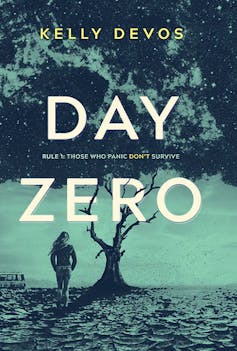
Davos’s Day Zero can be read as commenting on contemporary concerns about cyberterrorism and political corruption. Bell’s The End of the World Is Bigger than Love expresses similar anxieties, but is also prescient given the current pandemic.
War is the cause of disaster in Glenda Millard’s A Small Free Kiss in the Dark (2009) and John Marsden’s Tomorrow series. While Millard’s novel raises questions about homelessness, Marsden’s series expresses an anxiety about invasion from Asia. The author has expressed regret about this aspect of the books since their publication.
A latent xenophobia is also present in Claire Zorn’s, The Sky So Heavy (2013), in part because the nuclear disasters are attributed to “regions in the north of Asia”. Passive ideologies of racism that pervade some YA post-disaster novels are problematic, as are other underlying ideals that promote any form of discrimination.
Read more: Young adult fiction's dark themes give the hope to cope
Us Against The World
Literary texts that reinforce fear about Asia, particularly China, are especially problematic in the context of coronavirus, which reportedly saw an increase in racist attacks.
Panic buying and the stockpiling of goods during the early stages of the COVID-19 outbreak established an “us against them” dichotomy in our “struggle to survive”, reminiscent of YA post-disaster fiction.
Not everyone hoarded food and items for themselves though. Others showed compassion, donating toilet paper and food to those in need. Because of this, we were confronted with questions about how we want to survive.
YA post-disaster novels allow us to explore similar questions of humanity. In these fictional worlds, teenage characters are faced with moral dilemmas about who to help and who to harm. How does someone look out for themselves while still expressing empathy and consideration for others? How can characters maintain their humanity if their survival means another’s suffering or death?

Who To Save
Tied up with the question about how we survive, then, is who survives. The protagonist, Jinx, in Day Zero is continually faced with this dilemma. As she flees the corrupt government, Jinx must decide who to help, and how.
While Jinx readily uses violence to overcome her aggressors, she eventually must shoot to kill to save her stepsister. Doing so, Jinx loses a part of herself and becomes “something else”; she must now reconcile her actions with her sense of self.
Read more: Friday essay: why YA gothic fiction is booming - and girl monsters are on the rise
It’s not so far from the choices medical professionals in Italy, the United States and elsewhere have had to make about who to treat due to limited ventilators and a rapid influx of patients.
No matter the cause of catastrophe, the literary exploration of questions of survival provides opportunities for teenagers, parents and teachers to discuss a range of contemporary issues, including humane responses to disaster.
Given the current crisis we are in, perhaps it is time to critically read more YA post-disaster novels. If they hold up a mirror to our current attitudes and behaviours, they can help us reflect on our humanity, and on what and who we think matters.![]()
Troy Potter, Lecturer, The University of Melbourne, University of Melbourne
This article is republished from The Conversation under a Creative Commons license. Read the original article.
Snowy Waters
Published July 2, 2020 by NFSA
From The Film Australia Collection. Made by The National Film Board 1952. Directed by Bern Gandy.
Original synopsis: Australia’s greatest engineering undertaking, the Snowy River Hydroelectric Scheme, in the Southern Alps, is changing the geography of an area as big as Switzerland by completely altering the course of streams and rivers, and is intended to bring into agricultural production double the area now served by irrigation, and to provide double Australia’s present output of electrical power.
Exploring Your Options: Information Sessions Available In Further Study
LIVESTREAM UNSW Undergraduate Info and Insights Week
23 to 25 June
Designed for Year 11 and 12 students, we'll cover everything from scholarships and admissions to the UNSW student experience through a series of short livestreamed presentations. At the end of each session, you'll have the opportunity to participate in a live Q&A, where you can get all your questions answered.
https://www.events.unsw.edu.au/event/livestream-unsw-undergraduate-info-and-insights-week
Southern Cross Uni - Virtual Gold Coast Careers Festival
To 31 July
Want to discover your career pathway? We can help you explore your options at the virtual Gold Coast Careers Festival.
Engage with our educators, gain advice from qualified professionals, discover insights in engaging webinars, and obtain up to date advice through online live chat.
A world of opportunity awaits you. Whether you have no idea what career you want to pursue or you know exactly what you are aiming for, we can show you how to achieve your dream career.
Register your attendance.
https://www.scu.edu.au/engage/events/virtual-gold-coast-careers-festival.php
ACU Open Days are Moving Online
ACU Open Days give students the opportunity to ask questions about their dream course, the application process, pathway options, entry schemes and more. There will be three 2020 ACU Open Days shared across NSW and ACT on the 29th of August, and the 5th and 12th of September. Students can follow this link below to keep up to date with the 2020 Open Days.
Visit: acu.edu.au/uni-experience
UOW College Australia Now Accepting applications for 2021
UOW College provides pathways to the University of Wollongong. We offer uni preparation courses to support students and progress to university studies. We also provide VET courses for students seeking work-ready qualifications in Nursing or Fitness. These can also be used for a direct pathway to a bachelor level study. Find out more at below.
https://www.uowcollege.edu.au/study/high-school/
ACU - Talk with Exercise Scientists and Physiotherapists
1 July. 6pm
Join us online to hear from ACU alumni about their experiences working as exercise scientists, clinical exercise physiologists, sports scientists and physiotherapists. Take part in a Q&A session with our graduates to learn what a career in exercise science and physiotherapy is like.
CSESoc CompClub
CompClub is an organisation under UNSW CSESoc that promotes computing to high school students through free workshops.
2020 Virtual Winter Workshops
This year we will be providing 3 free workshops in an online format instead of in person! We will have a series of videos covering three workshops:
- Game Development (HTML/CSS)
- Cyber Security
- Web Development (Javascript)
There will also be a livestream covering an introduction to Python during the holidays (date TBD), where students can take part and ask questions in real time! We will be releasing the workshop videos on a schedule, starting on Monday 6th July.
There is no cost or registration needed and is open to all high school students of any ability. We will be releasing the virtual workshop site closer to the Winter School Holidays, and will update the link here once it is ready!
Visit: https://2020.compclub.com.au/

But Wait - There's More! Everything From Trains To Tractors Is Knocking On Your Door
Top Gun Apprenticeship Program
Applications now open for 2021 Apprenticeships with Land HQ top Gun program.
Whether you’re a school leaver or someone looking for a change in career path, our TOPGUN apprenticeship program could give you the start you’re looking for with LandHQ. We have apprenticeship opportunities available in Nowra, Penrith and Bowral. Go to the site below or to find out more contact Matt on 0428 613 284 or email hr@landhq.com.au:
Visit: http://landhq.com.au/careers
Sydney Trains Apprenticeships - Join the team that keeps Sydney moving!
We advertise apprenticeship positions in July on: https://iworkfor.nsw.gov.au and our apprentices commence in January of the following year.
If you’re looking for a rewarding career in a boom industry, there’s never been a better time to join the rail industry. Sydney Trains is the biggest passenger rail operator and maintainer in Australia and is the training ground for the NSW rail industry.
Sydney Trains offers a range of apprenticeships (PDF, 1.05 MB) in the electrical, telecommunications and mechanical engineering trades.
As a Sydney Trains apprentice, you’ll have access to a wealth of experience, a workforce that takes pride in its work, and a culture of collaboration and innovation. You’ll gain nationally recognised trade qualifications with opportunities to further develop your career post trade. Visit: https://www.transport.nsw.gov.au/sydneytrains/careers/sydney-trains-apprentices
For further information please contact Rhonda Moore on 0428 166 359 or email sydneytrainsapprenticeships@transport.nsw.gov.au
Electrical Pre-apprenticeship Program for Women
Sydney Trains has a genuine commitment to workforce diversity and has introduced some targeted recruitment programs to attract more women to apply for its apprenticeships.
The Electrical Pre-apprenticeship Program for Women (PDF, 1.2 MB) is a 3-week program in collaboration with an external training organisation that offers participants three national units of competency from the Certificate II in Electrotechnology. This program has proven to be very effective in assisting women interested in gaining an electrical apprenticeship.
The 2020 Program is on hold at present, but we are accepting expressions of interest and applicants will be contacted when confirmation is available - sydneytrainsapprenticeships@transport.nsw.gov.au.
Work Experience Program
Our Work Experience Program (PDF, 41.71 KB) offers opportunities for students to experience the world of work at Sydney Trains and gain a better understanding of the career options available in the rail industry.
You can spend a week with us and learn about:
- Diesel/Plant mechanics with our Heavy Plant team, which repairs and maintains a large fleet of track maintenance machines
- Our Business Studies program which will provide opportunities to gain experience at our training facility at Petersham in a range of office procedures and tasks
- Electro-technology apprenticeship options across our rail network including theory and practical training on rail signalling, rail substations, rail traction and everything you ever wanted to know about trains at one of our fleet maintenance depots.
Contact us
For further information please email us at: sydneytrainsapprenticeships@transport.nsw.gov.au.
Apprenticeships R Us – Keep an eye on the Apprenticeship Job Vacancies with Cars
The positions indicated below are our current vacancies that we are recruiting for right NOW. If you are a job seeker looking for an immediate start to your automotive apprenticeship and you see an apprenticeship that is right for you then don't delay and start an apprenticeship with us.
Visit: https://www.apprus.com.au/career-vacancies
Get a Dynamic Career with the TAFE NSW Bachelor of Early Childhood Education and Care (Birth-5)
Have you shown a keen interest in working with children? You may have a genuine desire to help our next generation grow and develop. A TAFE NSW degree in this career area is designed to develop early childhood teachers who can integrate theoretical knowledge into practical education and care skills. More info here: https://www.tafensw.edu.au/degrees/bachelor-of-early-childhood-education-and-care-birth-5
TAFE Bachelor of Applied Commerce
Designed in consultation with industry, the Bachelor of Applied Commerce provides you with the skills and knowledge you need to be a successful financial professional. Complete your major in either accounting or financial planning, or do a double major. As well as developing knowledge and skills in accounting and financial planning, you will study management, marketing, law, economics and business statistics, as well as doing an industry placement.
Alternatively, you can complete a Diploma of Applied Commerce by completing all first year subjects in the degree. Visit: https://www.tafensw.edu.au/degrees/bachelor-of-applied-commerce
Australian Patisserie Academy
250 Blaxland Road Ryde
Established in 2014, the TAFE NSW Australian Patisserie Academy was designed to give food enthusiasts, culinary professionals, businesses and individuals the opportunity to immerse themselves in the world of patisserie. Utilising the professional kitchens of TAFE NSW, the Academy team alongside international guest chefs, ensure you emerge with a dream patisserie skill set. From perfecting the art of cake decorating to baking the perfect sourdough, pulling exquisite sugar ribbons to creating one-of-a-kind chocolate show pieces, the Academy is dedicated to preserving the art of patisserie.
Classes are short, flexible and constantly changing to reflect industry trends. So whether you’re a passionate weekend baker or master chocolatier, there’s a course that’s your perfect mix.
Phone: 02 9448 6222 or Visit: https://www.tafensw.edu.au/australian-patisserie-academy?
Health and Fitness Careers - TAFE Career Snapshot
Which occupations in this industry are likely to have the largest employment growth over the next three years?
Visit: https://www.tafensw.edu.au/documents/60140/219174/Careers-Snapshot_Health_and_Fitness.pdf
Tourism Hospitality and Events - TAFE Career Snapshot
Which occupations in this industry are likely to have the largest employment growth over the next three years?
Automotive Trades and Services TAFE Career Snapshot
Which occupations in this industry are likely to have the largest employment growth over the next three years?
Where Can Students Find Out More About Tocal College
Take a tour on any area that takes your interest. Dairy, beef, sheep, horses, eggs, property, natural resources, bees. Other sources include our Website, Facebook, Careers Markets, 2019 AgVision or school tours. 02 4939 8888 or 1800 025 520. Visit: https://www.tocal.nsw.edu.au/farm-and-facilities/tocal-farms/tocal-virtual-farm-navigation
The Tocal Beekeepers Field Day
Saturday 10th October from 9am
Without bees we have no agriculture. Get along to this great event. There will be a full program of informative presentations, a large trade show to buy beekeeping supplies and more, live demonstrations, honey tasting and sales, and food and coffee available all day. Entry is free!
The Tocal Beekeepers Field Day has been running for 40 years, and is run by the Amateur Beekeepers Association, NSW Apiarists Association, NSW Department of Primary Industry and Tocal College.
Visit: https://www.tocal.nsw.edu.au/news-and-media/events/2020-tocal-beekeepers-field-day
Reminder - Tocal Farming and Agriculture Open Days
Friday 10 & 17 July
Friday 2 & 9 October
Our College Open Days are a wonderful opportunity to visit Tocal and experience first hand all that it can offer students who are eager for a rewarding career in agriculture, agribusiness or horse breeding and training.
The Open Days are held on the Fridays of the winter and spring school holidays and provide prospective students, their families and carers an ideal forum to visit the College and get a feel for what life as a student is really like. Should you require accommodation while attending the Open Days, Tocal College has a range of excellent and affordable accommodation options. These include motel rooms, flats and cottages. Please contact our accommodation booking team for further information at tocal.bookings@dpi.nsw.gov.au
Visit: https://www.tocal.nsw.edu.au/students/future-students/open-days
Stay Healthy During The HSC
In any ‘normal’ year the HSC requires dedication and focus as well as the support of friends and family.
This year hasn’t exactly panned out to be a ‘normal’ year, with announcements about changes to the HSC due to COVID-19.
Despite all the goings-on, students across NSW are continuing to study for their HSC with focus and determination, and we at NESA are here to help.
This year we are partnering with mental health organisation ReachOut to deliver news, information, guidance and advice to support all HSC students.
You’ll hear from experts, teachers, parents and other students as well as some inspiring spokespeople. This year we are planning to lighten your mental load with practical tips and tricks for staying active, connected and in charge of your wellbeing.
ReachOut’s Study Hub has heaps of info about taking a proactive approach to your mental health or where to go if you need more support. ReachOut’s Forums are great for sharing what’s going on for you and get ideas about the best ways to feel happy and well.
So follow and use #StayHealthyHSC for regular health and wellbeing updates and information.
View our range of social media images, posters and flyer to help you get involved and share the Stay Healthy HSC message with your community.

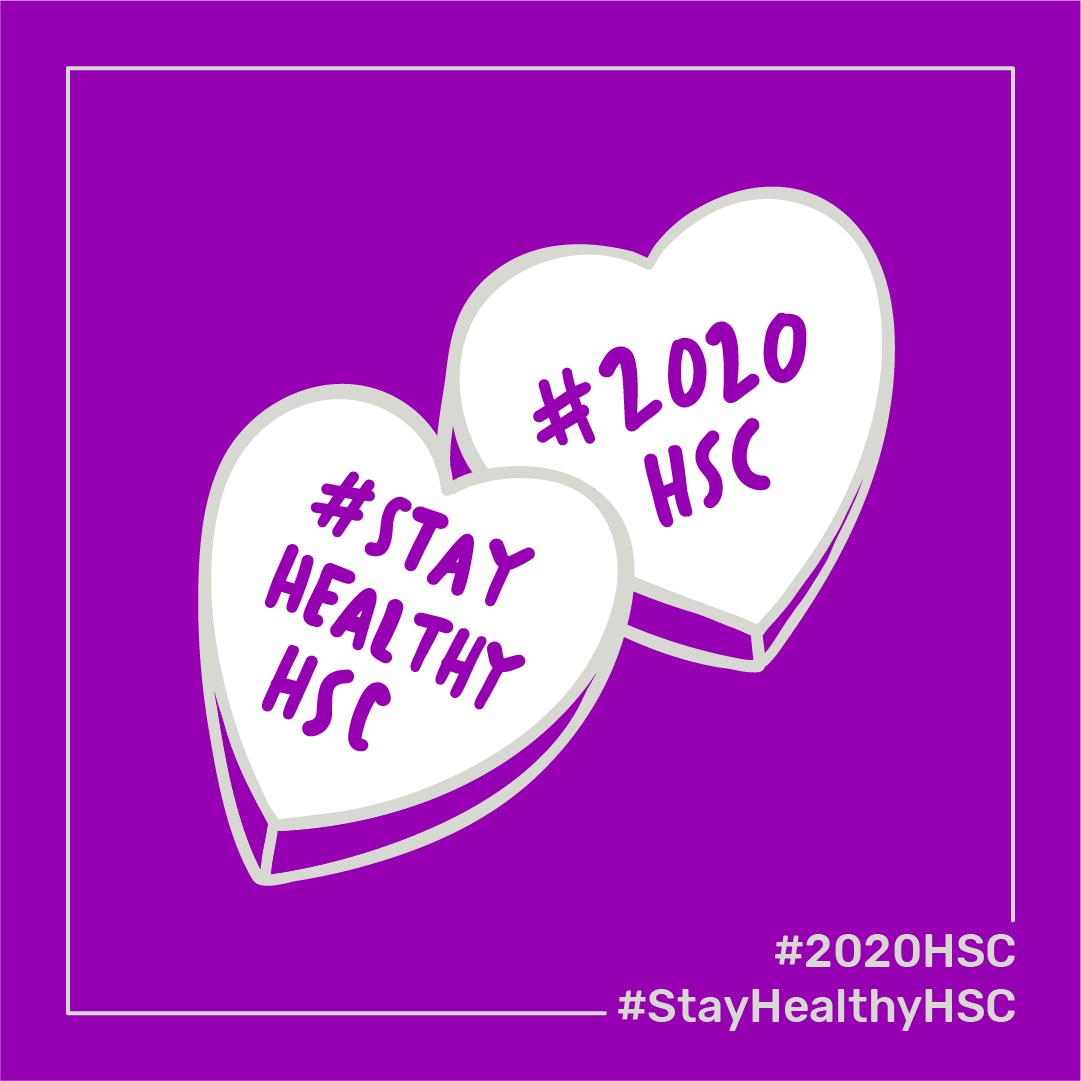
Fever-Associated Seizures After Vaccination Do Not Affect Development
Geologists Identify Deep-Earth Structures That May Signal Hidden Metal Lodes
Alarming Long-Term Effects Of Insecticides Weaken Ant Colonies
CSIRO Uses Lab-Grown ‘Lungs’ To Fight Respiratory Viruses
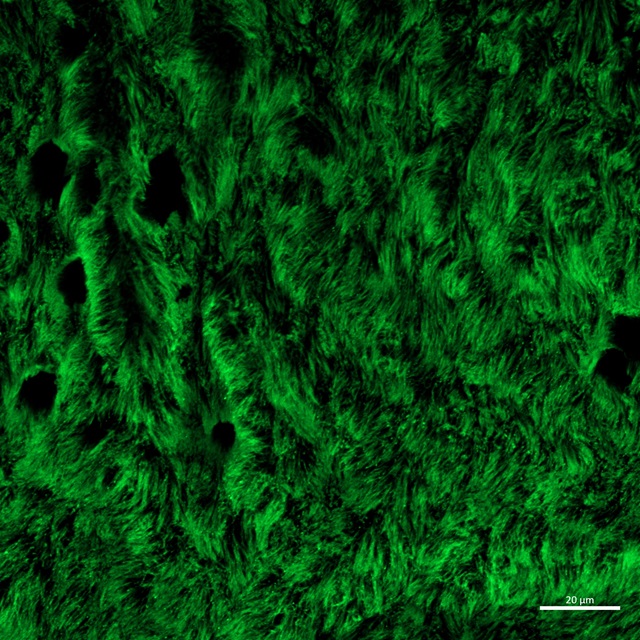
First Confirmed Underwater Aboriginal Archaeological Sites Found Off Australian Coast
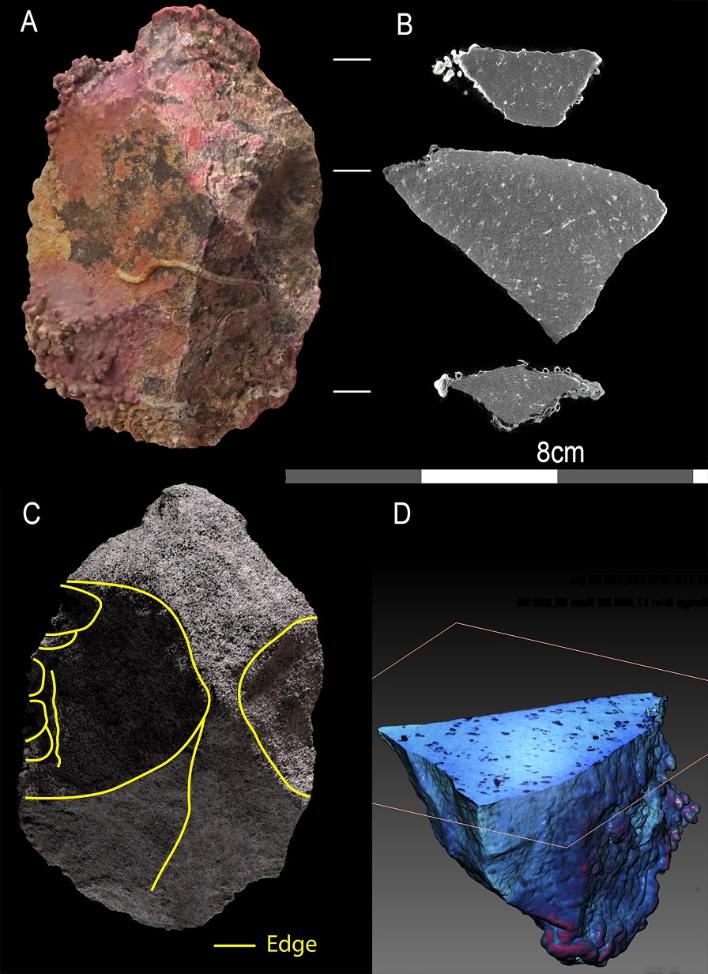
Disclaimer: These articles are not intended to provide medical advice, diagnosis or treatment. Views expressed here do not necessarily reflect those of Pittwater Online News or its staff.
